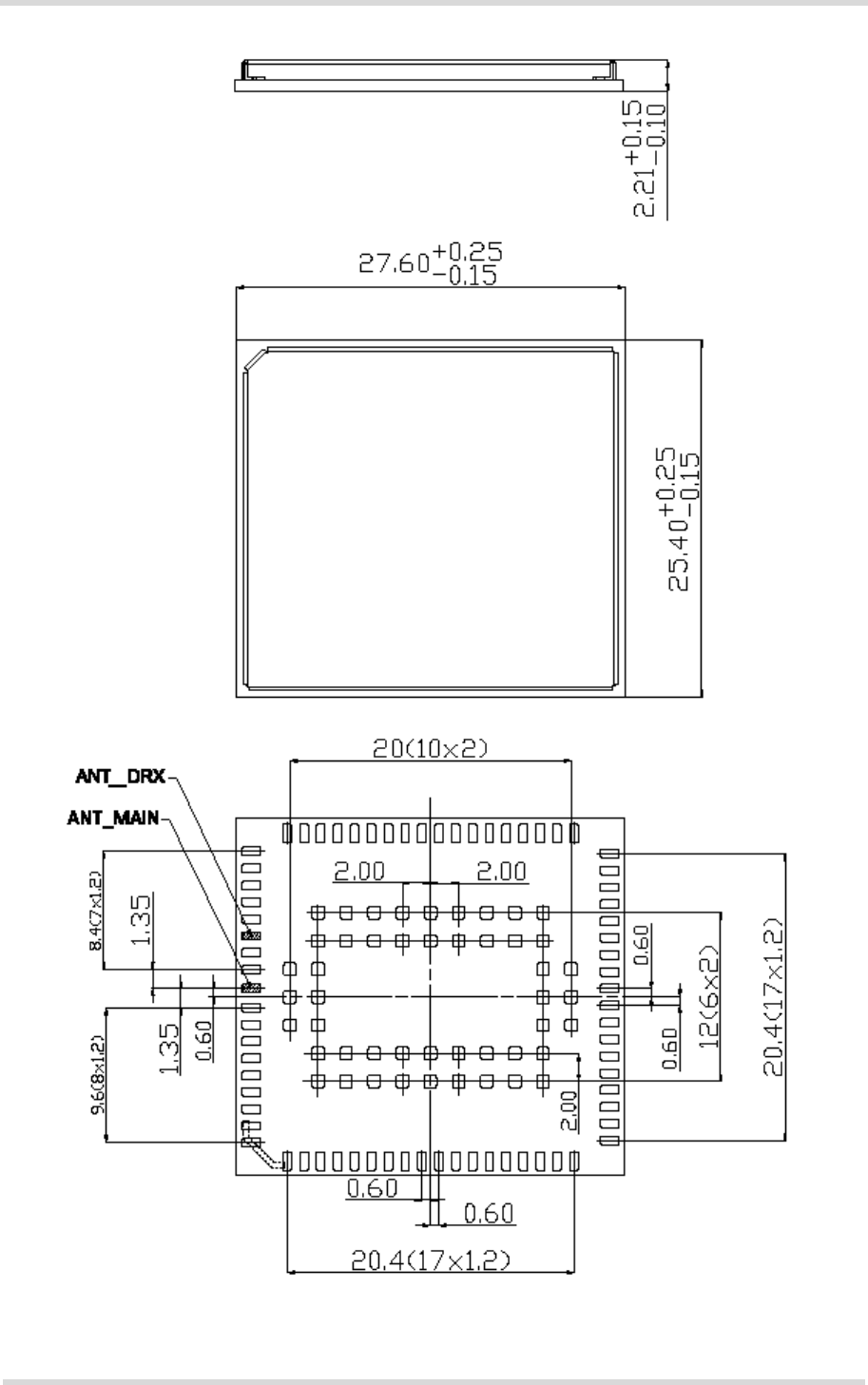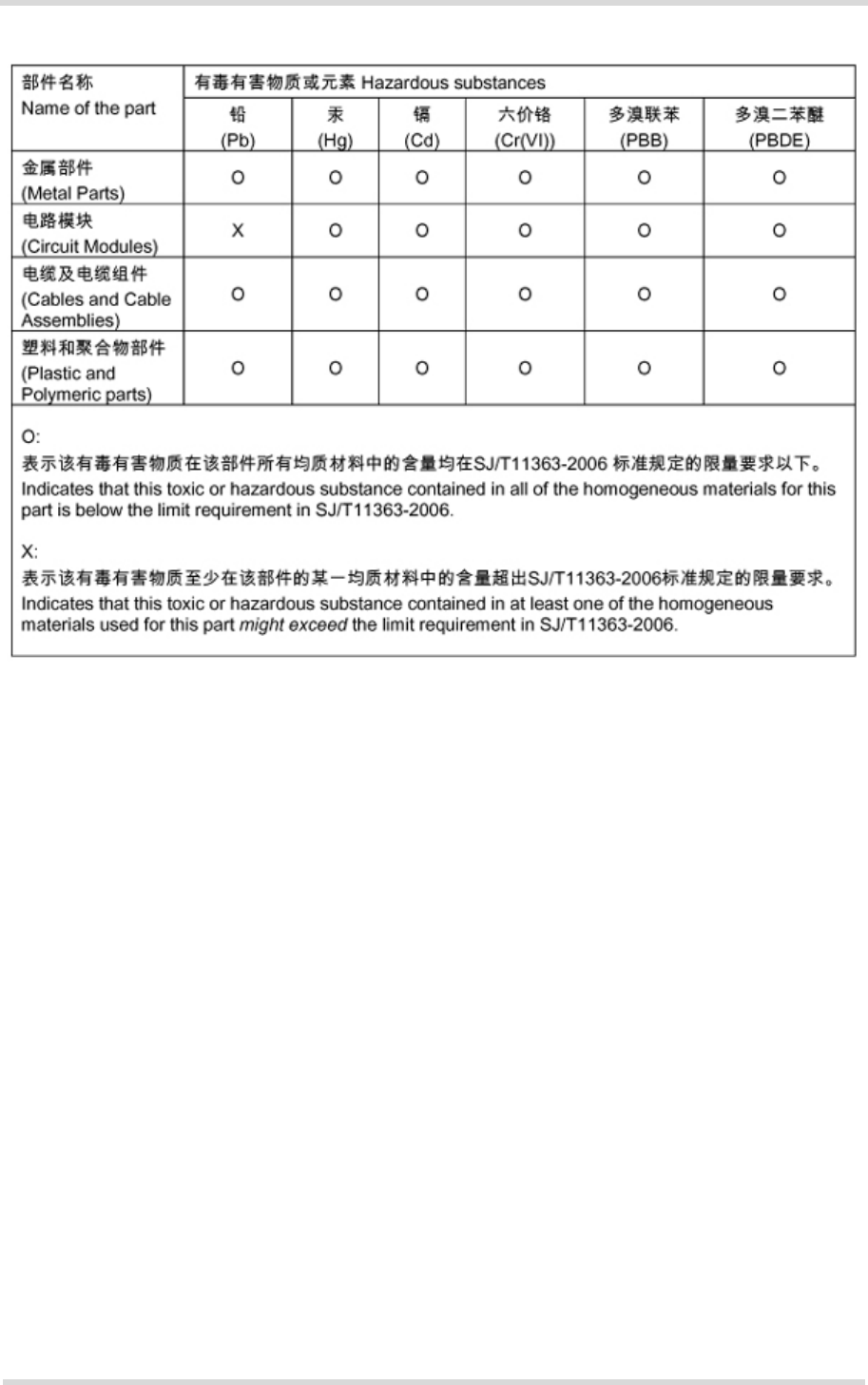THALES DIS AlS Deutschland ELS61-US LTE/WCDMA Module User Manual els61 us hid
Gemalto M2M GmbH LTE/WCDMA Module els61 us hid
TempConfidential_ELS61-US_User manual_Rev 1
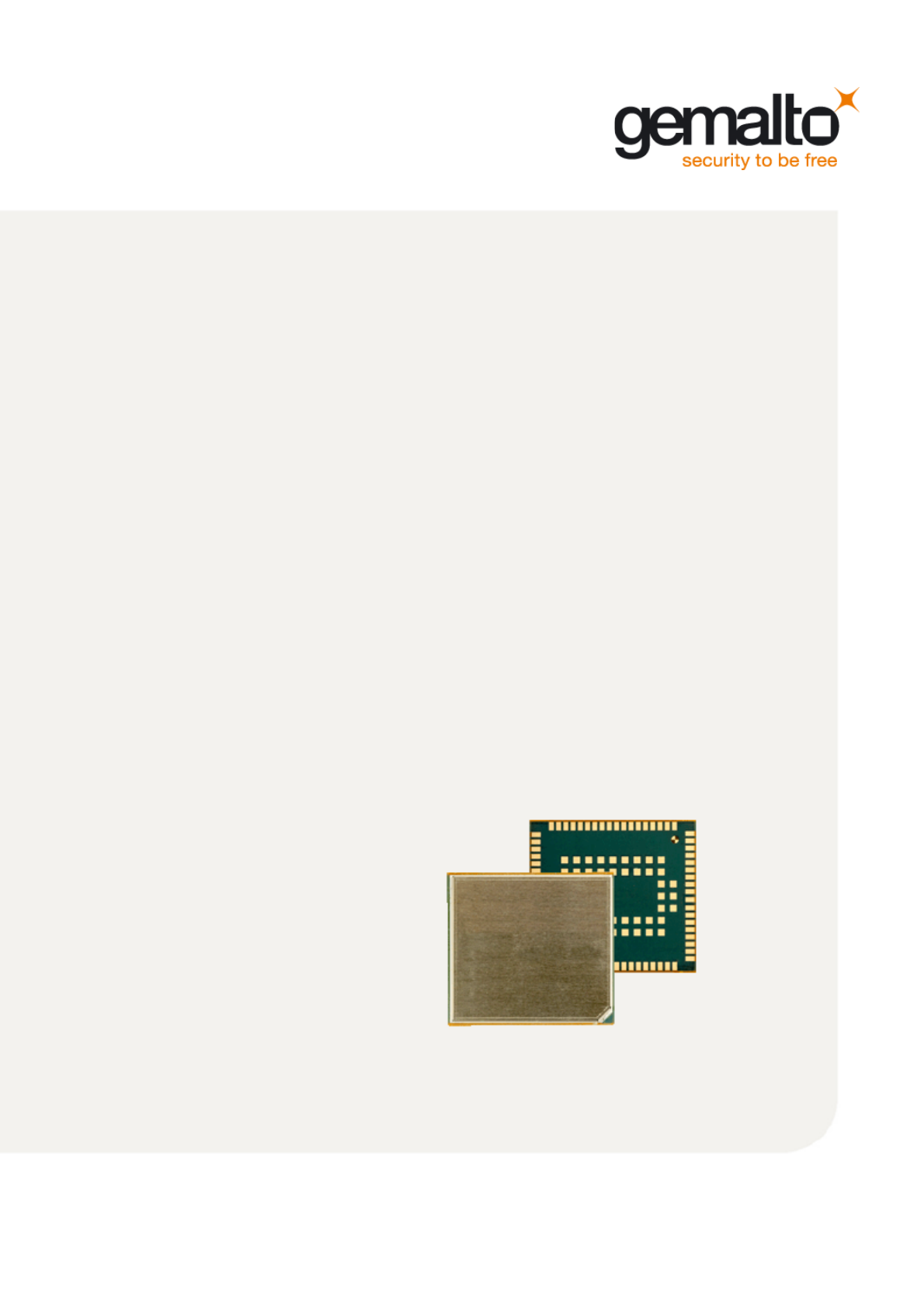
M2M.GEMALTO.COM
Cinterion® ELS61-US
Hardware Interface Overview
Version: 00.281
DocId: ELS61-US_HIO_v00.281

GENERAL NOTE
THE USE OF THE PRODUCT INCLUDING THE SOFTWARE AND DOCUMENTATION (THE "PROD-
UCT") IS SUBJECT TO THE RELEASE NOTE PROVIDED TOGETHER WITH PRODUCT. IN ANY
EVENT THE PROVISIONS OF THE RELEASE NOTE SHALL PREVAIL. THIS DOCUMENT CONTAINS
INFORMATION ON GEMALTO M2M PRODUCTS. THE SPECIFICATIONS IN THIS DOCUMENT ARE
SUBJECT TO CHANGE AT GEMALTO M2M'S DISCRETION. GEMALTO M2M GMBH GRANTS A NON-
EXCLUSIVE RIGHT TO USE THE PRODUCT. THE RECIPIENT SHALL NOT TRANSFER, COPY,
MODIFY, TRANSLATE, REVERSE ENGINEER, CREATE DERIVATIVE WORKS; DISASSEMBLE OR
DECOMPILE THE PRODUCT OR OTHERWISE USE THE PRODUCT EXCEPT AS SPECIFICALLY
AUTHORIZED. THE PRODUCT AND THIS DOCUMENT ARE PROVIDED ON AN "AS IS" BASIS ONLY
AND MAY CONTAIN DEFICIENCIES OR INADEQUACIES. TO THE MAXIMUM EXTENT PERMITTED
BY APPLICABLE LAW, GEMALTO M2M GMBH DISCLAIMS ALL WARRANTIES AND LIABILITIES.
THE RECIPIENT UNDERTAKES FOR AN UNLIMITED PERIOD OF TIME TO OBSERVE SECRECY
REGARDING ANY INFORMATION AND DATA PROVIDED TO HIM IN THE CONTEXT OF THE DELIV-
ERY OF THE PRODUCT. THIS GENERAL NOTE SHALL BE GOVERNED AND CONSTRUED
ACCORDING TO GERMAN LAW.
Copyright
Transmittal, reproduction, dissemination and/or editing of this document as well as utilization of its con-
tents and communication thereof to others without express authorization are prohibited. Offenders will be
held liable for payment of damages. All rights created by patent grant or registration of a utility model or
design patent are reserved.
Copyright © 2016, Gemalto M2M GmbH, a Gemalto Company
Trademark Notice
Gemalto, the Gemalto logo, are trademarks and service marks of Gemalto and are registered in certain
countries. Microsoft and Windows are either registered trademarks or trademarks of Microsoft Corpora-
tion in the United States and/or other countries. All other registered trademarks or trademarks mentioned
in this document are property of their respective owners.
ELS61-US_HIO_v00.281 2016-02-11
Confidential / Preliminary
Cinterion® ELS61-US Hardware Interface Overview
2
Page 2 of 40
Document Name: Cinterion® ELS61-US Hardware Interface Overview
Version: 00.281
Date: 2016-02-11
DocId: ELS61-US_HIO_v00.281
Status Confidential / Preliminary

Cinterion® ELS61-US Hardware Interface Overview
Contents
40
ELS61-US_HIO_v00.281 2016-02-11
Confidential / Preliminary
Page 3 of 40
Contents
1 Introduction ................................................................................................................. 6
1.1 Key Features at a Glance .................................................................................. 6
1.2 ELS61-US System Overview ............................................................................. 9
2 Interface Characteristics .......................................................................................... 10
2.1 Application Interface ........................................................................................ 10
2.1.1 USB Interface...................................................................................... 10
2.1.2 Serial Interface ASC0 ......................................................................... 11
2.1.3 Serial Interface ASC1 ......................................................................... 12
2.1.4 UICC/SIM/USIM Interface................................................................... 13
2.1.5 GPIO Interface .................................................................................... 15
2.1.6 I2C Interface ........................................................................................ 16
2.2 SPI Interface .................................................................................................... 16
2.2.1 PWM Interfaces .................................................................................. 17
2.2.2 Pulse Counter ..................................................................................... 17
2.2.3 Status LED.......................................................................................... 17
2.2.4 Fast Shutdown .................................................................................... 17
2.3 RF Antenna Interface....................................................................................... 18
2.3.1 Antenna Installation ............................................................................ 19
2.4 Sample Application .......................................................................................... 20
3 Operating Characteristics ........................................................................................ 22
3.1 Operating Modes ............................................................................................. 22
3.2 Power Supply................................................................................................... 23
4 Mechanical Dimensions ........................................................................................... 24
4.1 Mechanical Dimensions of ELS61-US ............................................................. 24
5 Regulatory and Type Approval Information ........................................................... 26
5.1 Directives and Standards................................................................................. 26
5.2 SAR requirements specific to portable mobiles ............................................... 29
5.3 Reference Equipment for Type Approval......................................................... 30
5.4 Compliance with FCC and IC Rules and Regulations ..................................... 31
6 Document Information.............................................................................................. 33
6.1 Revision History ............................................................................................... 33
6.2 Related Documents ......................................................................................... 33
6.3 Terms and Abbreviations ................................................................................. 34
6.4 Safety Precaution Notes .................................................................................. 37
7 Appendix.................................................................................................................... 38
7.1 List of Parts and Accessories........................................................................... 38

Cinterion® ELS61-US Hardware Interface Overview
Tables
114
ELS61-US_HIO_v00.281 2016-02-11
Confidential / Preliminary
Page 4 of 40
Tables
Table 1: Signals of the SIM interface (SMT application interface) ............................... 13
Table 2: GPIO lines and possible alternative assignment............................................ 15
Table 3: Return loss in the active band........................................................................ 18
Table 4: Overview of operating modes ........................................................................ 22
Table 5: Directives ....................................................................................................... 26
Table 6: Standards of North American type approval .................................................. 26
Table 7: Standards of European type approval............................................................ 26
Table 8: Requirements of quality ................................................................................. 27
Table 9: Standards of the Ministry of Information Industry of the
People’s Republic of China............................................................................ 27
Table 10: Toxic or hazardous substances or elements with defined concentration
limits............................................................................................................... 28
Table 11: List of parts and accessories.......................................................................... 38
Table 12: Molex sales contacts (subject to change) ...................................................... 39

Cinterion® ELS61-US Hardware Interface Overview
Figures
114
ELS61-US_HIO_v00.281 2016-02-11
Confidential / Preliminary
Page 5 of 40
Figures
Figure 1: ELS61-US system overview............................................................................. 9
Figure 2: USB circuit ..................................................................................................... 10
Figure 3: Serial interface ASC0..................................................................................... 11
Figure 4: Serial interface ASC1..................................................................................... 12
Figure 5: External UICC/SIM/USIM card holder circuit ................................................. 14
Figure 6: Schematic diagram of ELS61-US sample application.................................... 21
Figure 7: ELS61-US– top and bottom view................................................................... 24
Figure 8: Dimensions of ELS61-US (all dimensions in mm) ......................................... 25
Figure 9: Reference equipment for Type Approval ....................................................... 30

Cinterion® ELS61-US Hardware Interface Overview
1 Introduction
9
ELS61-US_HIO_v00.281 2016-02-11
Confidential / Preliminary
Page 6 of 40
1 Introduction
This document1 describes the hardware of the Cinterion® ELS61-US module. It helps you
quickly retrieve interface specifications, electrical and mechanical details and information on
the requirements to be considered for integrating further components.
1.1 Key Features at a Glance
1. The document is effective only if listed in the appropriate Release Notes as part of the technical docu-
mentation delivered with your Gemalto M2M product.
Feature Implementation
General
Frequency bands UMTS/HSPA+: Triple band, 850 (BdV) / AWS (BdIV) / 1900MHz (BdII)
LTE: Quad band, 700 (Bd12) / 850 (Bd5) / AWS (Bd4) / 1900MHz (Bd2)
Output power (according
to Release 99)
Class 3 (+24dBm +1/-3dB) for UMTS 1900,WCDMA FDD BdII
Class 3 (+24dBm +1/-3dB) for UMTS AWS, WCDMA FDD BdIV
Class 3 (+24dBm +1/-3dB) for UMTS 850, WCDMA FDD BdV
Output power (according
to Release 8)
Class 3 (+23dBm ±2dB) for LTE 1900,LTE FDD Bd2
Class 3 (+23dBm ±2dB) for LTE AWS, LTE FDD Bd4
Class 3 (+23dBm ±2dB) for LTE 850, LTE FDD Bd5
Class 3 (+23dBm ±2dB) for LTE 700, LTE FDD Bd12
Power supply 3.0V to 4.5V
Operating temperature
(board temperature)
Normal operation: -30°C to +85°C
Extended operation: -40°C to +90°C
Physical Dimensions: 27.6mm x 25.4mm x 2.2mm
Weight: approx. TBD.g
RoHS All hardware components fully compliant with EU RoHS Directive
LTE features
3GPP Release 9 UE CAT 1 supported
DL 10.2Mbps, UL 5.2Mbps
HSPA features
3GPP Release 8 DL 7.2Mbps, UL 5.7Mbps
HSDPA Cat.8 / HSUPA Cat.6 data rates
Compressed mode (CM) supported according to 3GPP TS25.212
UMTS features
3GPP Release 4 PS data rate – 384 kbps DL / 384 kbps UL
CS data rate – 64 kbps DL / 64 kbps UL

Cinterion® ELS61-US Hardware Interface Overview
1.1 Key Features at a Glance
9
ELS61-US_HIO_v00.281 2016-02-11
Confidential / Preliminary
Page 7 of 40
SMS Point-to-point MT and MO
Cell broadcast
Text and PDU mode
Storage: SIM card plus SMS locations in mobile equipment
Software
AT commands Hayes 3GPP TS 27.007, TS 27.005, Gemalto M2M
AT commands for RIL compatibility
Java™ Open Platform Java™ Open Platform with
• Java™ profile IMP-NG & CLDC 1.1 HI
• Secure data transmission via HTTPS/SSL
• Multi-threading programming and multi-application execution
Major benefits: seamless integration into Java applications, ease of pro-
gramming, no need for application microcontroller, extremely cost-efficient
hardware and software design – ideal platform for industrial applications.
The memory space available for Java programs is around 30MB in the flash
file system and around 18MB RAM. Application code and data share the
space in the flash file system and in RAM.
Microsoft™ compatibility RIL for Pocket PC and Smartphone
SIM Application Toolkit SAT letter classes b, c, e; with BIP
Firmware update Generic update from host application over ASC0 or USB modem.
Interfaces
Module interface Surface mount device with solderable connection pads (SMT application
interface). Land grid array (LGA) technology ensures high solder joint reli-
ability and allows the use of an optional module mounting socket.
For more information on how to integrate SMT modules see also [3]. This
application note comprises chapters on module mounting and application
layout issues as well as on additional SMT application development equip-
ment.
USB USB 2.0 High Speed (480Mbit/s) device interface, Full Speed (12Mbit/s)
compliant
2 serial interfaces ASC0 (shared with GPIO lines):
• 8-wire modem interface with status and control lines, unbalanced, asyn-
chronous
• Adjustable baud rates: 1,200bps to 921,600bps
• Autobauding: 1,200bps to 230,400bps
• Supports RTS0/CTS0 hardware flow control.
ASC1 (shared with GPIO lines):
• 4-wire, unbalanced asynchronous interface
• Adjustable baud rates: 1,200bps to 921,60bps
• Autobauding: 1,200bps to 230,400bps
• Supports RTS1/CTS1 hardware flow control
UICC interface Supported SIM/USIM cards: 3V, 1.8V
Feature Implementation

Cinterion® ELS61-US Hardware Interface Overview
1.1 Key Features at a Glance
9
ELS61-US_HIO_v00.281 2016-02-11
Confidential / Preliminary
Page 8 of 40
GPIO interface 22 GPIO lines comprising:
13 lines shared with ASC0, ASC1 and SPI lines, with network status indica-
tion, PWM functionality, fast shutdown and pulse counter
9 GPIO lines not shared
I2C interface Supports I2C serial interface
SPI interface Serial peripheral interface, shared with GPIO lines
Antenna interface pads 50Ω. UMTS/LTE main antenna, UMTS/LTE Rx Diversity antenna
Power on/off, Reset
Power on/off Switch-on by hardware signal ON
Switch-off by AT command
Switch off by hardware signal FST_SHDN instead of AT command
Automatic switch-off in case of critical temperature or voltage conditions
Reset Orderly shutdown and reset by AT command
Emergency reset by hardware signal EMERG_RST
Special features
Real time clock Timer functions via AT commands
Phonebook SIM and phone
Evaluation kit
Evaluation module ELS61-US module soldered onto a dedicated PCB that can be connected
to an adapter in order to be mounted onto the DSB75.
DSB75 DSB75 Development Support Board designed to test and type approve
Gemalto M2M modules and provide a sample configuration for application
engineering. A special adapter is required to connect the ELS61-US evalu-
ation module to the DSB75.
Feature Implementation
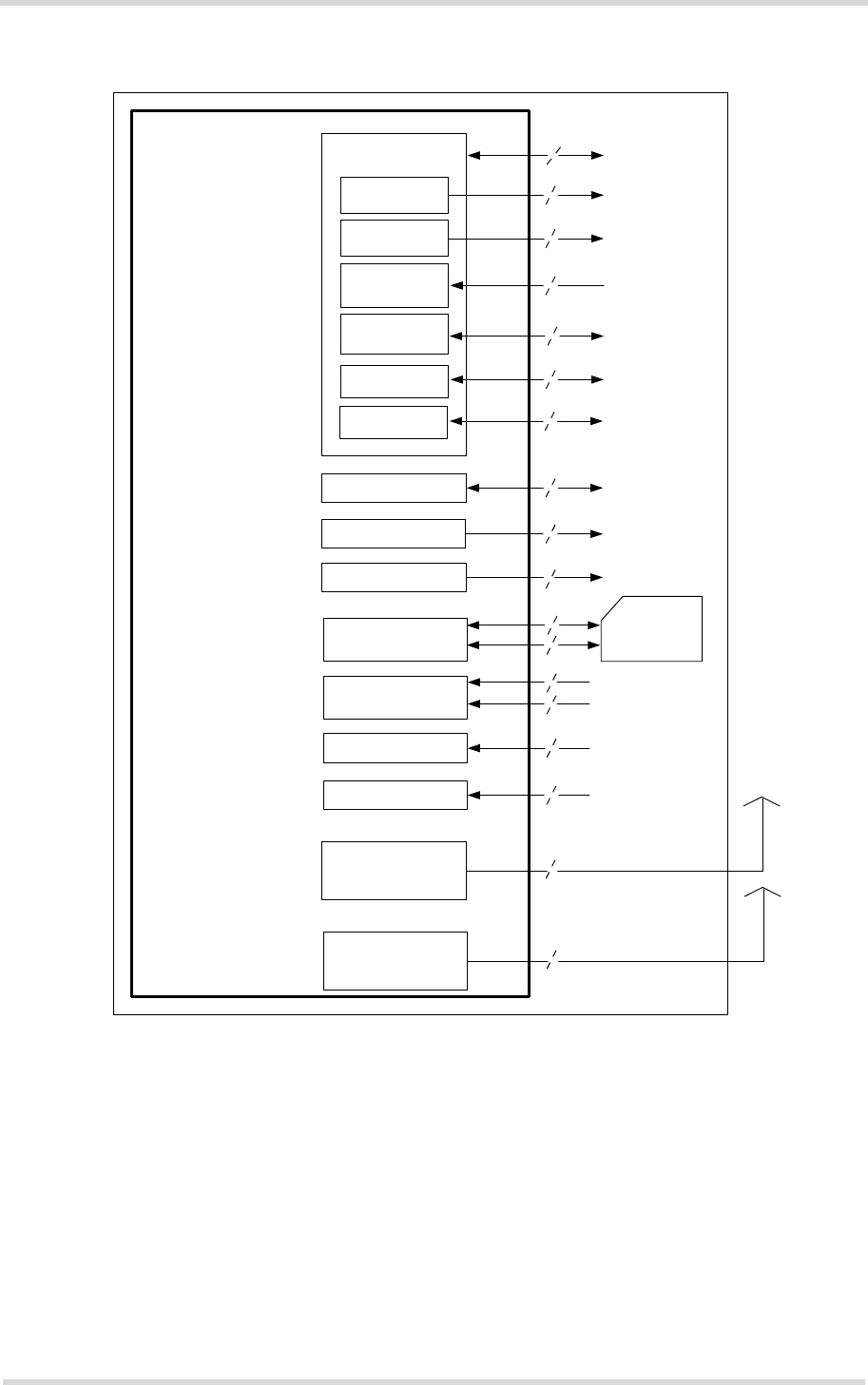
Cinterion® ELS61-US Hardware Interface Overview
1.2 ELS61-US System Overview
9
ELS61-US_HIO_v00.281 2016-02-11
Confidential / Preliminary
Page 9 of 40
1.2 ELS61-US System Overview
Figure 1: ELS61-US system overview
GPIO
interface
I2C
USB
ASC0 lines
ASC1/SPI
CONTROL
RTC
POWER
Rx diversity
antenna
(UMTS/LTE)
Module
SIM interface
(with SIM detection)
SIM card
Application
Power supply
Backup supply
Emergency reset
ON
Serial interface/
SPI interface
Serial modem
interface lines
I2C
GPIO
3
4
4
5
2
9
1
1
1
2
USB
Rx diversity
1
Status LED
1
DAC (PWM) PWM
2
Fast
shutdown Fast shutdown
1
1
COUNTER Pulse counter
1
ASC0 lines
Serial modem
interface lines/
SPI interface
4
Main antenna
(UMTS/LTE)
Main antenna
1
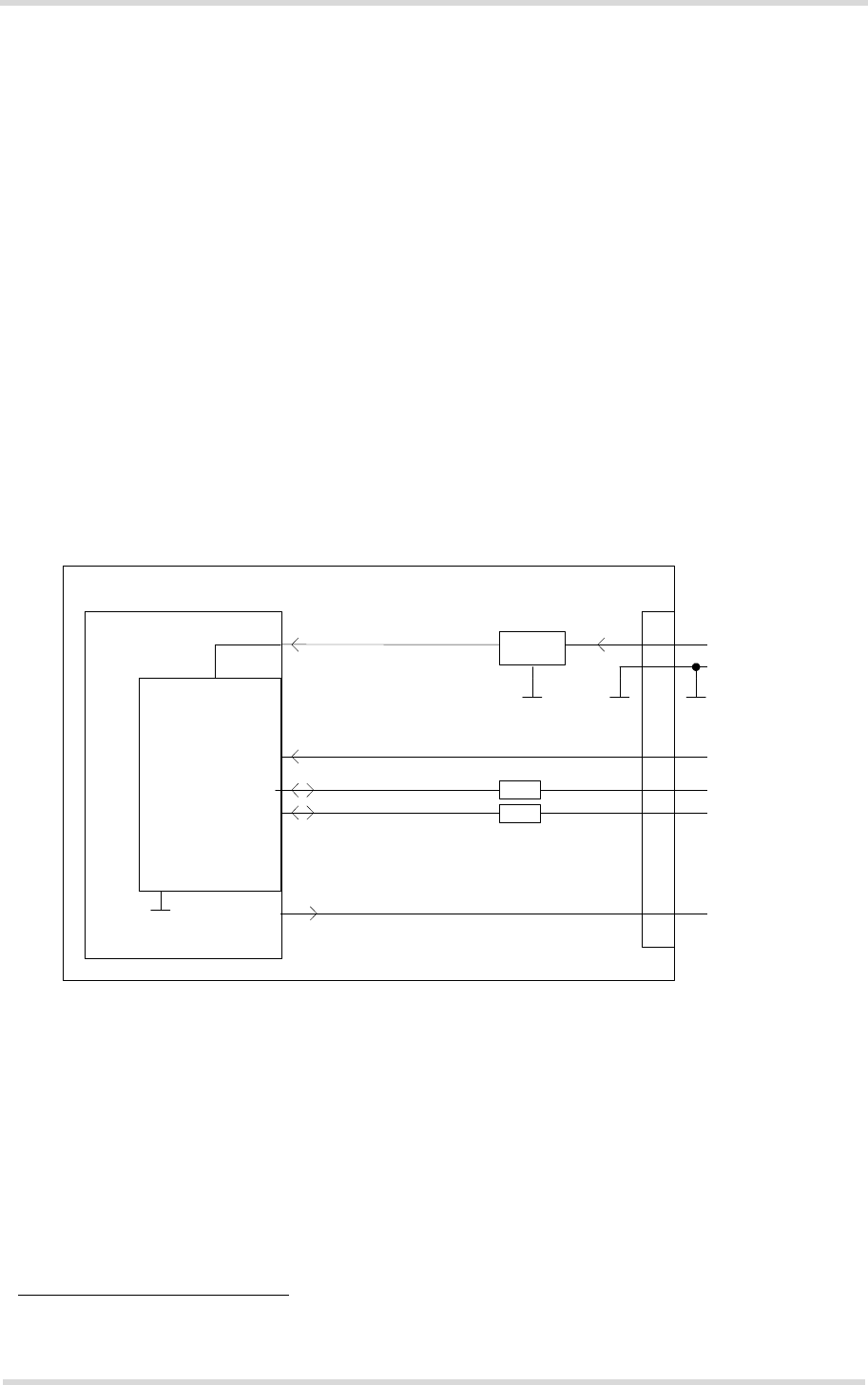
Cinterion® ELS61-US Hardware Interface Overview
2 Interface Characteristics
21
ELS61-US_HIO_v00.281 2016-02-11
Confidential / Preliminary
Page 10 of 40
2 Interface Characteristics
ELS61-US is equipped with an SMT application interface that connects to the external applica-
tion. The SMT application interface incorporates the various application interfaces as well as
the RF antenna interface.
2.1 Application Interface
2.1.1 USB Interface
ELS61-US supports a USB 2.0 High Speed (480Mbit/s) device interface that is Full Speed
(12Mbit/s) compliant. The USB interface is primarily intended for use as command and data in-
terface and for downloading firmware.
The external application is responsible for supplying the VUSB_IN line. This line is used for ca-
ble detection only. The USB part (driver and transceiver) is supplied by means of BATT+. This
is because ELS61-US is designed as a self-powered device compliant with the “Universal Se-
rial Bus Specification Revision 2.0”1.
Figure 2: USB circuit
To properly connect the module's USB interface to the external application, a USB 2.0 compat-
ible connector and cable or hardware design is required. Furthermore, the USB modem driver
distributed with ELS61-US needs to be installed.
1. The specification is ready for download on http://www.usb.org/developers/docs/
VBUS
DP
DN
VREG (3V075)
BATT+
USB_DP2)
lin. reg.
GND
Module
Detection only VUSB_IN
USB part1)
RING0
Host wakeup
1) All serial (including RS) and pull-up resistors for data lines are implemented.
USB_DN2)
2) If the USB interface is operated in High Speed mode (480MHz), it is recommended to take
special care routing the data lines USB_DP and USB_DN. Application layout should in this
case implement a differential impedance of 90 ohms for proper signal integrity.
RS
RS
SMT
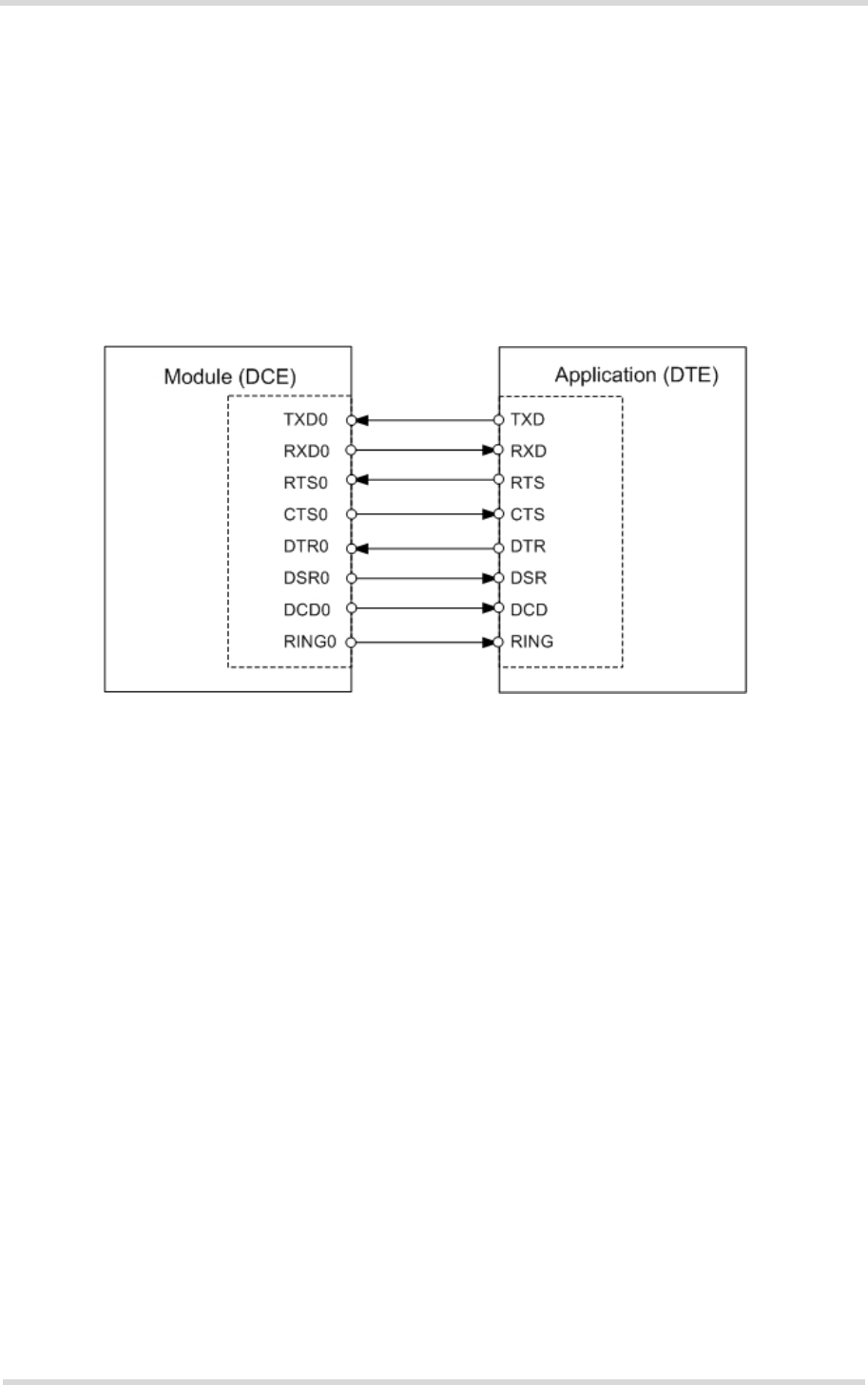
Cinterion® ELS61-US Hardware Interface Overview
2.1 Application Interface
21
ELS61-US_HIO_v00.281 2016-02-11
Confidential / Preliminary
Page 11 of 40
2.1.2 Serial Interface ASC0
ELS61-US offers an 8-wire unbalanced, asynchronous modem interface ASC0 conforming to
ITU-T V.24 protocol DCE signalling. The electrical characteristics do not comply with ITU-T
V.28. The significant levels are 0V (for low data bit or active state) and 1.8V (for high data bit
or inactive state).
ELS61-US is designed for use as a DCE. Based on the conventions for DCE-DTE connections
it communicates with the customer application (DTE) using the following signals:
• Port TXD @ application sends data to the module’s TXD0 signal line
• Port RXD @ application receives data from the module’s RXD0 signal line
Figure 3: Serial interface ASC0
Features:
• Includes the data lines TXD0 and RXD0, the status lines RTS0 and CTS0 and, in addition,
the modem control lines DTR0, DSR0, DCD0 and RING0.
• The RING0 signal serves to indicate incoming calls and other types of URCs (Unsolicited
Result Code). It can also be used to send pulses to the host application, for example to
wake up the application from power saving state.
• Configured for 8 data bits, no parity and 1 stop bit.
• ASC0 can be operated at fixed bit rates from 1,200bps up to 921,600bps.
• Autobauding supports bit rates from 1,200bps up to 230,400bps.
• Supports RTS0/CTS0 hardware flow control. The hardware hand shake line RTS0 has an
internal pull down resistor causing a low level signal, if the line is not used and open.
Although hardware flow control is recommended, this allows communication by using only
RXD and TXD lines.
• Wake up from SLEEP mode by RTS0 activation.
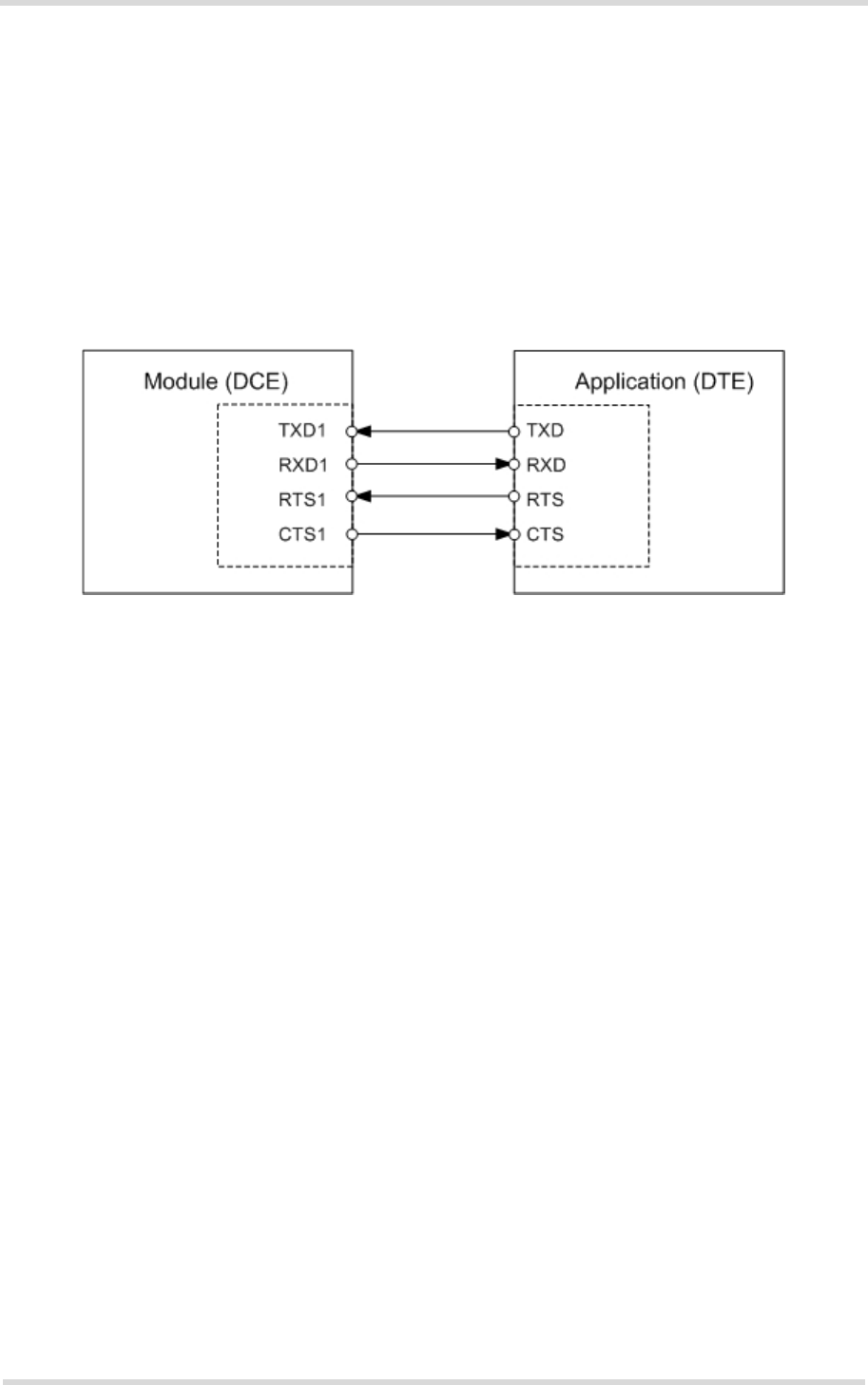
Cinterion® ELS61-US Hardware Interface Overview
2.1 Application Interface
21
ELS61-US_HIO_v00.281 2016-02-11
Confidential / Preliminary
Page 12 of 40
2.1.3 Serial Interface ASC1
Four ELS61-US GPIO lines can be configured as ASC1 interface signals to provide a 4-wire
unbalanced, asynchronous modem interface ASC1 conforming to ITU-T V.24 protocol DCE
signalling. The electrical characteristics do not comply with ITU-T V.28. The significant levels
are 0V (for low data bit or active state) and 1.8V (for high data bit or inactive state).
ELS61-US is designed for use as a DCE. Based on the conventions for DCE-DTE connections
it communicates with the customer application (DTE) using the following signals:
• Port TXD @ application sends data to module’s TXD1 signal line
• Port RXD @ application receives data from the module’s RXD1 signal line
Figure 4: Serial interface ASC1
Features
• Includes only the data lines TXD1 and RXD1 plus RTS1 and CTS1 for hardware hand-
shake.
• On ASC1 no RING line is available.
• Configured for 8 data bits, no parity and 1 or 2 stop bits.
• ASC1 can be operated at fixed bit rates from 1,200 bps to 921,600 bps.
• Autobauding supports bit rates from 1,200bps up to 230,400bps.
• Supports RTS1/CTS1 hardware flow. The hardware hand shake line RTS0 has an internal
pull down resistor causing a low level signal, if the line is not used and open. Although hard-
ware flow control is recommended, this allows communication by using only RXD and TXD
lines.

Cinterion® ELS61-US Hardware Interface Overview
2.1 Application Interface
21
ELS61-US_HIO_v00.281 2016-02-11
Confidential / Preliminary
Page 13 of 40
2.1.4 UICC/SIM/USIM Interface
ELS61-US has an integrated UICC/SIM/USIM interface compatible with the 3GPP 31.102 and
ETSI 102 221. This is wired to the host interface in order to be connected to an external SIM
card holder. Five pads on the SMT application interface are reserved for the SIM interface.
The UICC/SIM/USIM interface supports 3V and 1.8V SIM cards. .
The CCIN signal serves to detect whether a tray (with SIM card) is present in the card holder.
To take advantage of this feature, an appropriate SIM card detect switch is required on the card
holder. For example, this is true for the model supplied by Molex, which has been tested to op-
erate with ELS61-US and is part of the Gemalto M2M reference equipment submitted for type
approval. See Section 7.1 for Molex ordering numbers.
Note [1]: No guarantee can be given, nor any liability accepted, if loss of data is encountered after removing
the SIM card during operation. Also, no guarantee can be given for properly initializing any SIM card that
the user inserts after having removed the SIM card during operation. In this case, the application must
restart ELS61-US.
Note [2]: On the evaluation board, the CCIN signal is inverted, thus the CCIN signal is by default high and
will change to a low level if a SIM card is inserted.
Table 1: Signals of the SIM interface (SMT application interface)
Signal Description
GND Separate ground connection for SIM card to improve EMC.
CCCLK Chipcard clock
CCVCC SIM supply voltage.
CCIO Serial data line, input and output.
CCRST Chipcard reset
CCIN Input on the baseband processor for detecting a SIM card tray in the holder. If the SIM is
removed during operation the SIM interface is shut down immediately to prevent destruc-
tion of the SIM. The CCIN signal is by default low and will change to high level if a SIM card
is inserted.
The CCIN signal is mandatory for applications that allow the user to remove the SIM card
during operation.
The CCIN signal is solely intended for use with a SIM card. It must not be used for any other
purposes. Failure to comply with this requirement may invalidate the type approval of
ELS61-US.
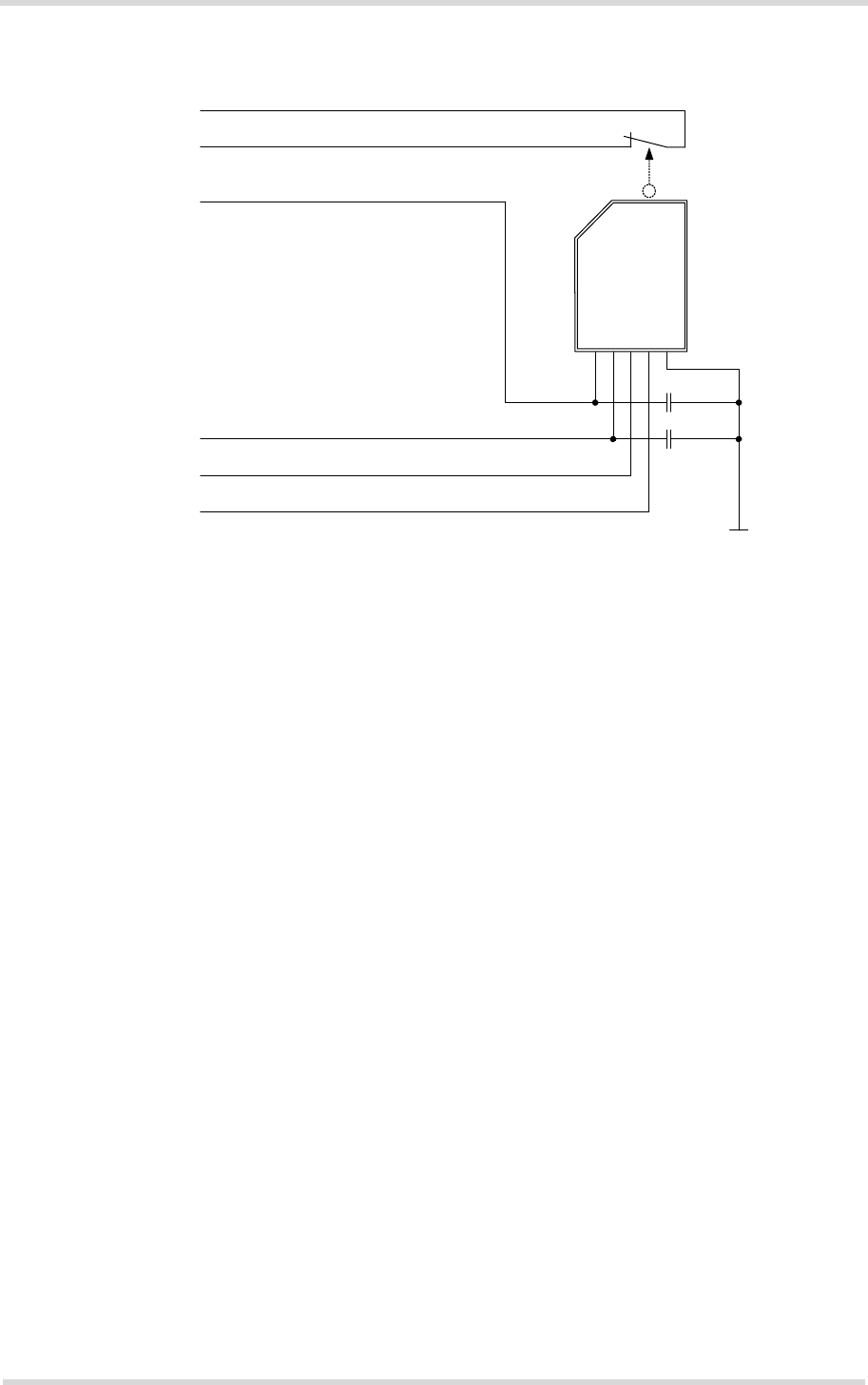
Cinterion® ELS61-US Hardware Interface Overview
2.1 Application Interface
21
ELS61-US_HIO_v00.281 2016-02-11
Confidential / Preliminary
Page 14 of 40
The figure below shows a circuit to connect an external SIM card holder.
Figure 5: External UICC/SIM/USIM card holder circuit
The total cable length between the SMT application interface pads on ELS61-US and the pads
of the external SIM card holder must not exceed 100mm in order to meet the specifications of
3GPP TS 51.010-1 and to satisfy the requirements of EMC compliance.
To avoid possible cross-talk from the CCCLK signal to the CCIO signal be careful that both
lines are not placed closely next to each other. A useful approach is using a GND line to shield
the CCIO line from the CCCLK line.
SIM
CCVCC
CCRST
CCIO
CCCLK
220nF
1nF
CCIN
V180

Cinterion® ELS61-US Hardware Interface Overview
2.1 Application Interface
21
ELS61-US_HIO_v00.281 2016-02-11
Confidential / Preliminary
Page 15 of 40
2.1.5 GPIO Interface
ELS61-US offers a GPIO interface with 22 GPIO lines. The GPIO lines are shared with other
interfaces or functions: Fast shutdown (see Section 2.2.4), status LED (see Section 2.2.3), the
PWM functionality (see Section 2.2.1), an pulse counter (see Section 2.2.2), ASC0 (see Sec-
tion 2.1.2), ASC1 (see Section 2.1.3), an SPI interface (see Section 2.2).
The following table shows the configuration variants for the GPIO pads. All variants are mutu-
ally exclusive, i.e. a pad configured for instance as Status LED is locked for alternative usage.
After startup, the above mentioned alternative GPIO line assignments can be configured using
AT commands (see [1]). The configuration is non-volatile and available after module restart.
Table 2: GPIO lines and possible alternative assignment
GPIO Fast Shutdown Status LED PWM Pulse Counter ASC0 ASC1 SPI
GPIO1 DTR0
GPIO2 DCD0
GPIO3 DSR0 SPI_CLK
GPIO4 FST_SHDN
GPIO5 Status LED
GPIO6 PWM2
GPIO7 PWM1
GPIO8 COUNTER
GPIO11
GPIO12
GPIO13
GPIO14
GPIO15
GPIO16 RXD1 MOSI
GPIO17 TXD1 MISO
GPIO18 RTS1
GPIO19 CTS1 SPI_CS
GPIO20
GPIO21
GPIO22
GPIO23
GPIO24 RING0

Cinterion® ELS61-US Hardware Interface Overview
2.2 SPI Interface
21
ELS61-US_HIO_v00.281 2016-02-11
Confidential / Preliminary
Page 16 of 40
2.1.6 I2C Interface
I2C is a serial, 8-bit oriented data transfer bus for bit rates up to 400kbps in Fast mode. It con-
sists of two lines, the serial data line I2CDAT and the serial clock line I2CCLK. The module acts
as a single master device, e.g. the clock I2CCLK is driven by the module. I2CDAT is a bi-direc-
tional line. Each device connected to the bus is software addressable by a unique 7-bit ad-
dress, and simple master/slave relationships exist at all times. The module operates as master-
transmitter or as master-receiver. The customer application transmits or receives data only on
request of the module.
The I2C interface can be powered via the V180 line of ELS61-US. If connected to the V180 line,
the I2C interface will properly shut down when the module enters the Power Down mode.
Note: Good care should be taken when creating the PCB layout of the host application: The
traces of I2CCLK and I2CDAT should be equal in length and as short as possible.
2.2 SPI Interface
Four ELS61-US GPIO interface lines can be configured as Serial Peripheral Interface (SPI).
The SPI is a synchronous serial interface for control and data transfer between ELS61-US and
the external application. Only one application can be connected to the SPI and the interface
supports only master mode. The transmission rates are up to 6.5Mbit/s. The SPI interface com-
prises the two data lines MOSI and MISO, the clock line SPI_CLK a well as the chip select line
SPI_CS.

Cinterion® ELS61-US Hardware Interface Overview
2.2 SPI Interface
21
ELS61-US_HIO_v00.281 2016-02-11
Confidential / Preliminary
Page 17 of 40
2.2.1 PWM Interfaces
The GPIO6 and GPIO7 interface lines can be configured as Pulse Width Modulation interface
lines PWM1 and PWM2. The PWM interface lines can be used, for example, to connect buzz-
ers. The PWM1 line is shared with GPIO7 and the PWM2 line is shared with GPIO6 (for GPIOs
see Section 2.1.5). GPIO and PWM functionality are mutually exclusive.
2.2.2 Pulse Counter
The GPIO8 line can be configured as pulse counter line COUNTER. The pulse counter inter-
face can be used, for example, as a clock (for GPIOs see Section 2.1.5).
2.2.3 Status LED
The GPIO5 interface line can be configured to drive a status LED that indicates different oper-
ating modes of the module (for GPIOs see Section 2.1.5). GPIO and LED functionality are mu-
tually exclusive.
2.2.4 Fast Shutdown
The GPIO4 interface line can be configured as fast shutdown signal line FST_SHDN. The con-
figured FST_SHDN line is an active low control signal and must be applied for at least 10 mil-
liseconds. If unused this line can be left open because of a configured internal pull-up resistor.

Cinterion® ELS61-US Hardware Interface Overview
2.3 RF Antenna Interface
21
ELS61-US_HIO_v00.281 2016-02-11
Confidential / Preliminary
Page 18 of 40
2.3 RF Antenna Interface
The ELS61-US UMTS/LTE antenna interface comprises a UMTS/LTE main antenna as well as
a UMTS/LTE Rx diversity antenna to improve signal reliability and quality1. The RF interface
has an impedance of 50Ω. ELS61-US is capable of sustaining a total mismatch at the antenna
line without any damage, even when transmitting at maximum RF power.
The external antenna must be matched properly to achieve best performance regarding radi-
ated power, modulation accuracy and harmonic suppression. Antenna matching networks are
not included on the ELS61-US module and should be placed in the host application if the an-
tenna does not have an impedance of 50Ω.
Regarding the return loss ELS61-US provides the following values in the active band:
1. By delivery default the UMTS/LTE Rx diversity antenna is configured as available for the module since
its usage is mandatory for LTE. Please refer to [1] for details on how to configure antenna settings.
Table 3: Return loss in the active band
State of module Return loss of module Recommended return loss of application
Receive > 8dB > 12dB
Transmit not applicable > 12dB

Cinterion® ELS61-US Hardware Interface Overview
2.3 RF Antenna Interface
21
ELS61-US_HIO_v00.281 2016-02-11
Confidential / Preliminary
Page 19 of 40
2.3.1 Antenna Installation
The antenna is connected by soldering the antenna pad (ANT_MAIN or ANT_DRX) and its
neighboring ground pads (GND) directly to the application’s PCB. The antenna pads are the
antenna reference points (ARP) for ELS61-US. All RF data specified throughout this document
is related to the ARP.
The distance between the antenna pad and its neighboring GND pads has been optimized for
best possible impedance. To prevent mismatch, special attention should be paid to these pads
on the application‘s PCB.
The wiring of the antenna connection, starting from the antenna pad to the application‘s anten-
na should result in a 50Ω line impedance. Line width and distance to the GND plane needs to
be optimized with regard to the PCB’s layer stack.
To prevent receiver desensitization due to interferences generated by fast transients like high
speed clocks on the external application PCB, it is recommended to realize the antenna con-
nection line using embedded Stripline rather than Micro-Stripline technology.
For type approval purposes, the use of a 50Ω coaxial antenna connector (U.FL-R-SMT) might
be necessary. In this case the U.FL-R-SMT connector should be placed as close as possible
to ELS61-US‘s antenna pad.

Cinterion® ELS61-US Hardware Interface Overview
2.4 Sample Application
21
ELS61-US_HIO_v00.281 2016-02-11
Confidential / Preliminary
Page 20 of 40
2.4 Sample Application
Figure 6 shows a typical example of how to integrate a ELS61-US module with an application.
Usage of the various host interfaces depends on the desired features of the application.
Because of the very low power consumption design, current flowing from any other source into
the module circuit must be avoided, for example reverse current from high state external control
lines. Therefore, the controlling application must be designed to prevent reverse current flow.
Otherwise there is the risk of undefined states of the module during startup and shutdown or
even of damaging the module.
Because of the high RF field density inside the module, it cannot be guaranteed that no self
interference might occur, depending on frequency and the applications grounding concept. The
potential interferers may be minimized by placing small capacitors (47pF) at suspected lines
(e.g. RXD0, VDDLP, and ON).
While developing SMT applications it is strongly recommended to provide test points
for certain signals, i.e., lines to and from the module - for debug and/or test purposes.
The SMT application should allow for an easy access to these signals. For details on
how to implement test points see [3].
The EMC measures are best practice recommendations. In fact, an adequate EMC strategy for
an individual application is very much determined by the overall layout and, especially, the po-
sition of components.
Note: ELS61-US is not intended for use with cables longer than 3m.
Disclaimer
No warranty, either stated or implied, is provided on the sample schematic diagram shown in
Figure 6 and the information detailed in this section. As functionality and compliance with na-
tional regulations depend to a great amount on the used electronic components and the indi-
vidual application layout manufacturers are required to ensure adequate design and operating
safeguards for their products using ELS61-US modules.
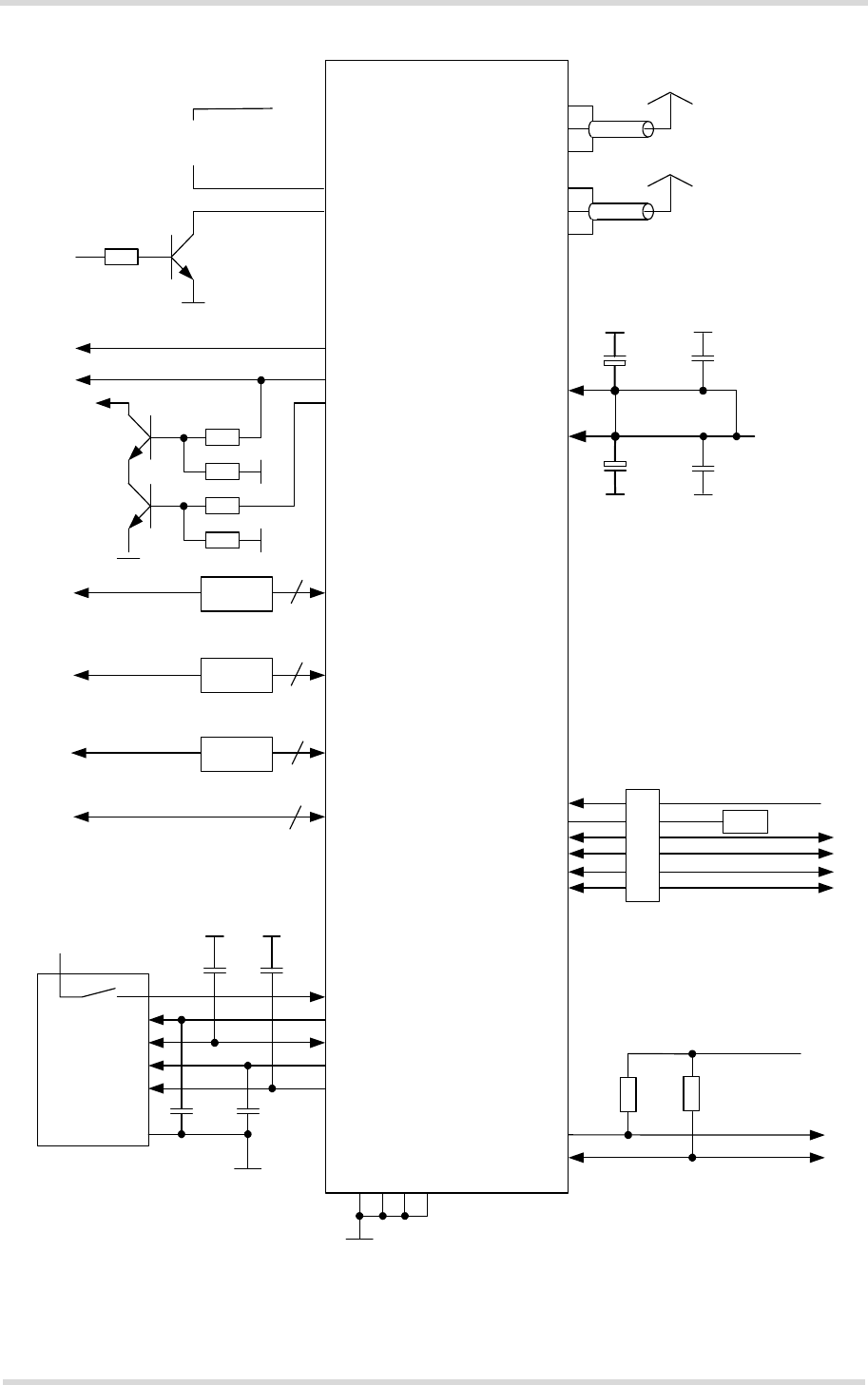
Cinterion® ELS61-US Hardware Interface Overview
2.4 Sample Application
21
ELS61-US_HIO_v00.281 2016-02-11
Confidential / Preliminary
Page 21 of 40
Figure 6: Schematic diagram of ELS61-US sample application
VCORE
V180
ASC0 (including GPIO1...GPIO3 for
DSR0, DTR0, DCD0 and GPIO24 for
RING0)/SPI_CLK (for DSR0)
GPIO16...GPIO19/
ASC1/
SPI
8
4
CCVCC
CCIO
CCCLK
CCIN
CCRST
SIM
V180
220nF 1nF
I2CCLK
I2CDAT
2.2k
V180
GPIO4 (FST_SHDN)
GPIO5 (Status LED)
GPIO6 (PWM)
GPIO7 (PWM)
GPIO8 (COUNTER)
GPIO11...GPIO15
LED
GND
GND
GND
ANT_MAIN
BATT+RF
Power supply
Main antenna
ELS6x
All SIM components should be
close to card holder. Keep SIM
wires low capacitive.
*10pF *10pF
* add optional 10pF for SIM protection
against RF (internal Antenna)
50µF,
Low ESR! 33pF
Blocking**
Blocking**
Blocking**
PWR_IND
BATT+BB
53
204
GPIO20...GPIO23
4
Blocking**
100k
4.7k
100k
22k
2.2k
3USB
150µF,
Low ESR!
33pF
GND
GND
ANT_DRX
Diversity antenna
ON
EMERG_RST
RESET
VDDLP
100k
VDDLP
Switch on
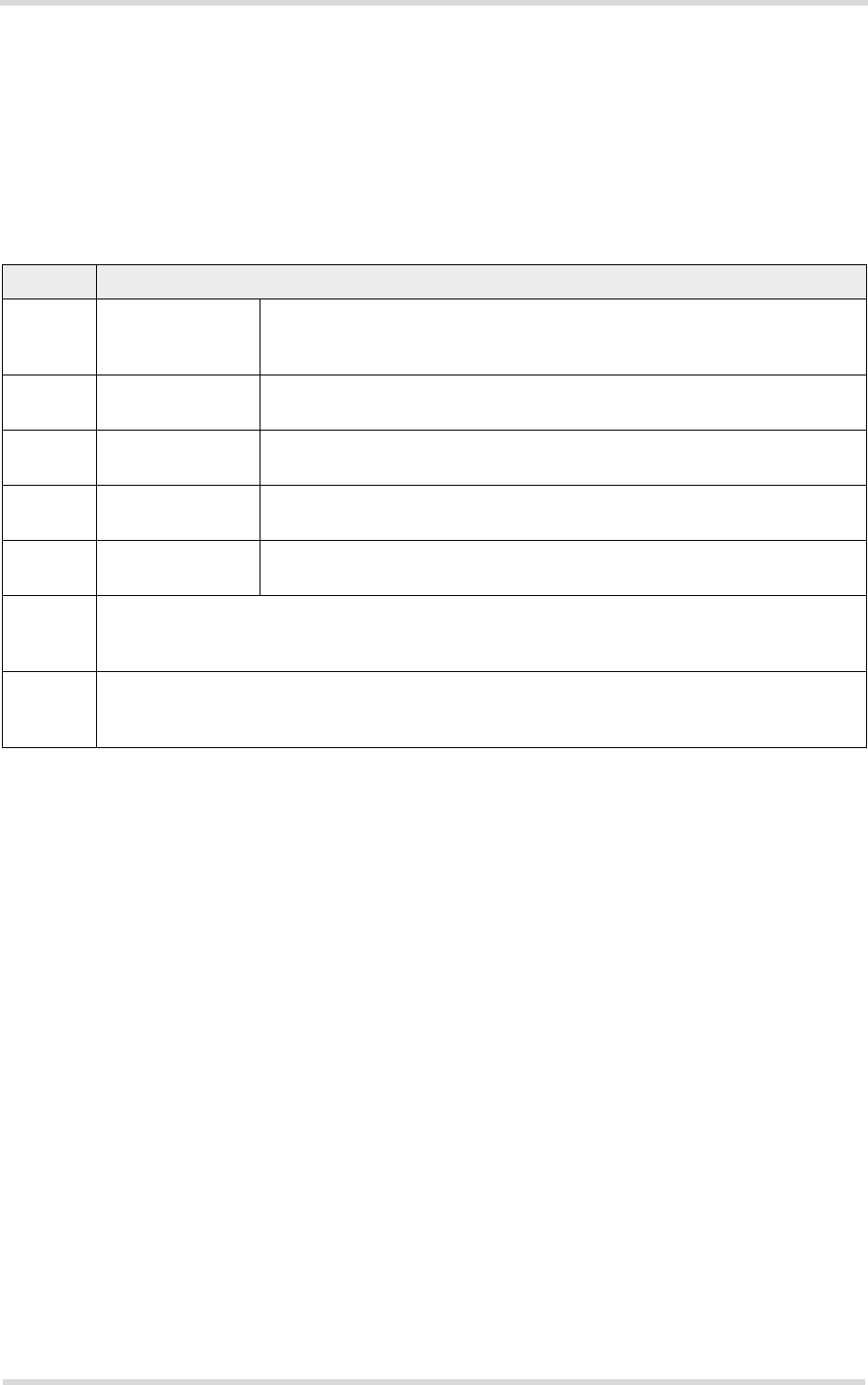
Cinterion® ELS61-US Hardware Interface Overview
3 Operating Characteristics
23
ELS61-US_HIO_v00.281 2016-02-11
Confidential / Preliminary
Page 22 of 40
3 Operating Characteristics
3.1 Operating Modes
The table below briefly summarizes the various operating modes referred to throughout the
document.
Table 4: Overview of operating modes
Mode Function
Normal
operation
UMTS / HSPA /
LTE SLEEP
Power saving set automatically when no call is in progress and the USB
connection is suspended by host or not present and no active commu-
nication via ASC0.
UMTS / HSPA /
LTE IDLE
Power saving disabled or an USB connection not suspended, but no
call in progress.
UMTS DATA UMTS data transfer in progress. Power consumption depends on net-
work settings (e.g. TPC Pattern) and data transfer rate.
HSPA DATA HSPA data transfer in progress. Power consumption depends on net-
work settings (e.g. TPC Pattern) and data transfer rate.
LTE DATA LTE data transfer in progress. Power consumption depends on network
settings (e.g. TPC Pattern) and data transfer rate.
Power
Down
Normal shutdown after sending the power down command. Only a voltage regulator is
active for powering the RTC. Software is not active. Interfaces are not accessible. Operat-
ing voltage remains applied.
Airplane
mode
Airplane mode shuts down the radio part of the module, causes the module to log off from
the network and disables all AT commands whose execution requires a radio connection.
Airplane mode can be controlled by AT command (see [1]).

Cinterion® ELS61-US Hardware Interface Overview
3.2 Power Supply
23
ELS61-US_HIO_v00.281 2016-02-11
Confidential / Preliminary
Page 23 of 40
3.2 Power Supply
ELS61-US needs to be connected to a power supply at the SMT application interface - 2 lines
BATT+, and GND. There are two separate voltage domains for BATT+:
•BATT+
BB with a line mainly for the baseband power supply.
•BATT+
RF with a line for the UMTS/LTE power amplifier supply.
Please note that throughout the document BATT+ refers to both voltage domains and power
supply lines - BATT+BB and BATT+RF.
The power supply of ELS61-US has to be a single voltage source at BATT+BB and BATT+RF. It
must be able to provide the peak current during the uplink transmission.
All the key functions for supplying power to the device are handled by the power management
section of the analog controller. This IC provides the following features:
• Stabilizes the supply voltages for the baseband using low drop linear voltage regulators and
a DC-DC step down switching regulator.
• Switches the module's power voltages for the power-up and -down procedures.
• SIM switch to provide SIM power supply.
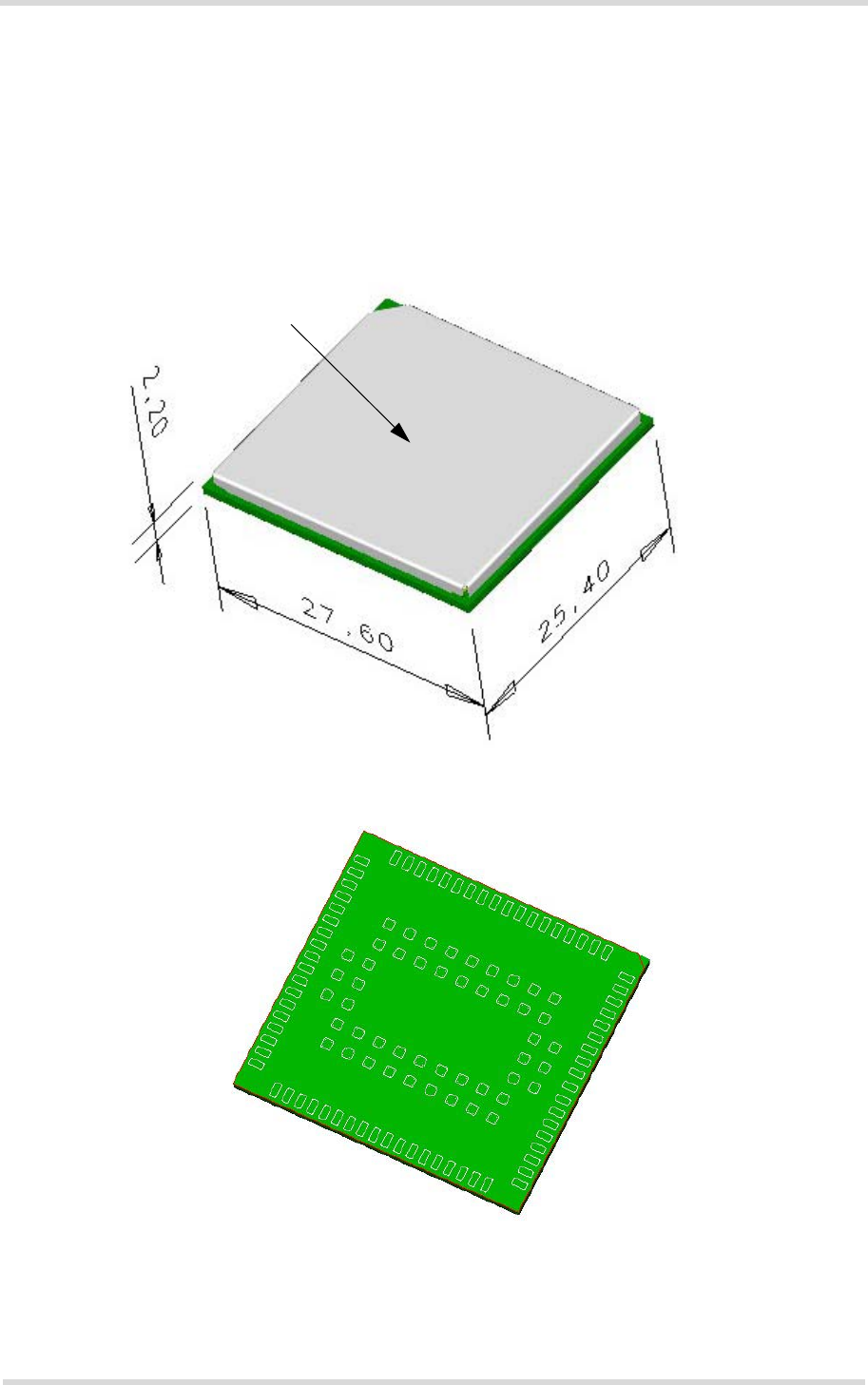
Cinterion® ELS61-US Hardware Interface Overview
4 Mechanical Dimensions
25
ELS61-US_HIO_v00.281 2016-02-11
Confidential / Preliminary
Page 24 of 40
4 Mechanical Dimensions
4.1 Mechanical Dimensions of ELS61-US
Figure 7 shows the top and bottom view of ELS61-US and provides an overview of the board's
mechanical dimensions. For further details see Figure 8.
Figure 7: ELS61-US– top and bottom view
Product label
Top view
Bottom view
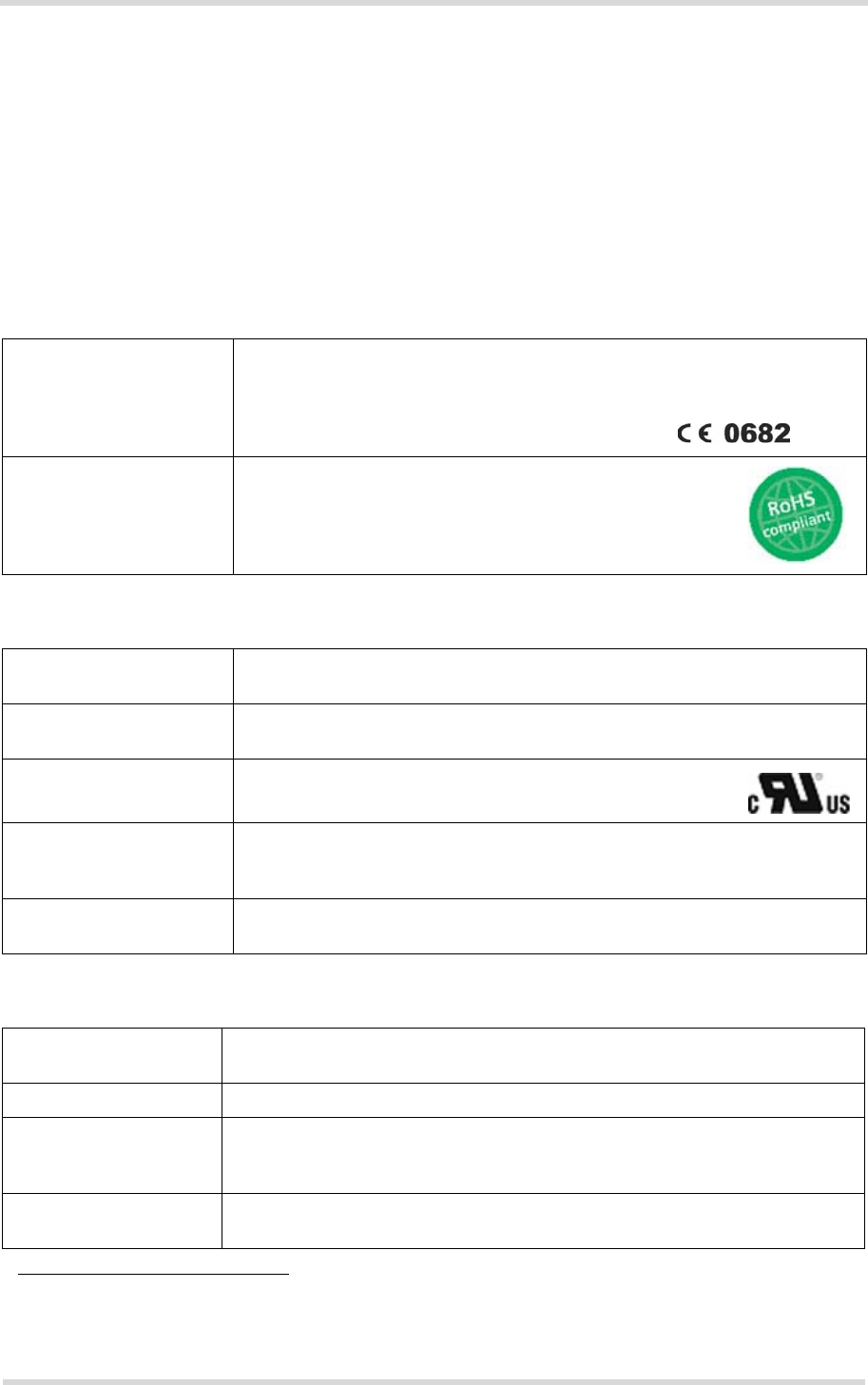
Cinterion® ELS61-US Hardware Interface Overview
5 Regulatory and Type Approval Information
32
ELS61-US_HIO_v00.281 2016-02-11
Confidential / Preliminary
Page 26 of 40
5 Regulatory and Type Approval Information
5.1 Directives and Standards
ELS61-US is designed to comply with the directives and standards listed below.
It is the responsibility of the application manufacturer to ensure compliance of the final product
with all provisions of the applicable directives and standards as well as with the technical spec-
ifications provided in the "ELS61-US Hardware Interface Description".1
1. Manufacturers of applications which can be used in the US shall ensure that their applications have a
PTCRB approval. For this purpose they can refer to the PTCRB approval of the respective module.
Table 5: Directives
1999/05/EC Directive of the European Parliament and of the council of 9 March 1999
on radio equipment and telecommunications terminal equipment and the
mutual recognition of their conformity (in short referred to as R&TTE Direc-
tive 1999/5/EC).
The product is labeled with the CE conformity mark
2002/95/EC (RoHS 1)
2011/65/EC (RoHS 2)
Directive of the European Parliament and of the Council
of 27 January 2003 (and revised on 8 June 2011) on the
restriction of the use of certain hazardous substances in
electrical and electronic equipment (RoHS)
Table 6: Standards of North American type approval
CFR Title 47 Code of Federal Regulations, Part 22 and Part 24 (Telecommunications,
PCS); US Equipment Authorization FCC
OET Bulletin 65
(Edition 97-01)
Evaluating Compliance with FCC Guidelines for Human Exposure to
Radiofrequency Electromagnetic Fields
UL 60 950-1 Product Safety Certification (Safety requirements)
NAPRD.03 V5.15 Overview of PCS Type certification review board Mobile Equipment Type
Certification and IMEI control
PCS Type Certification Review board (PTCRB)
RSS132 (Issue2)
RSS133 (Issue5)
Canadian Standard
Table 7: Standards of European type approval
3GPP TS 51.010-1 Digital cellular telecommunications system (Release 7); Mobile Station
(MS) conformance specification;
GCF-CC V3.49 Global Certification Forum - Certification Criteria
ETSI EN 301 489-01
V1.9.2
Electromagnetic Compatibility and Radio spectrum Matters (ERM); Electro-
magnetic Compatibility (EMC) standard for radio equipment and services;
Part 1: Common Technical Requirements
ETSI EN 301 489-07
V1.3.1
Electromagnetic Compatibility and Radio spectrum Matters (ERM); Electro-
magnetic Compatibility (EMC) standard for radio equipment and services;
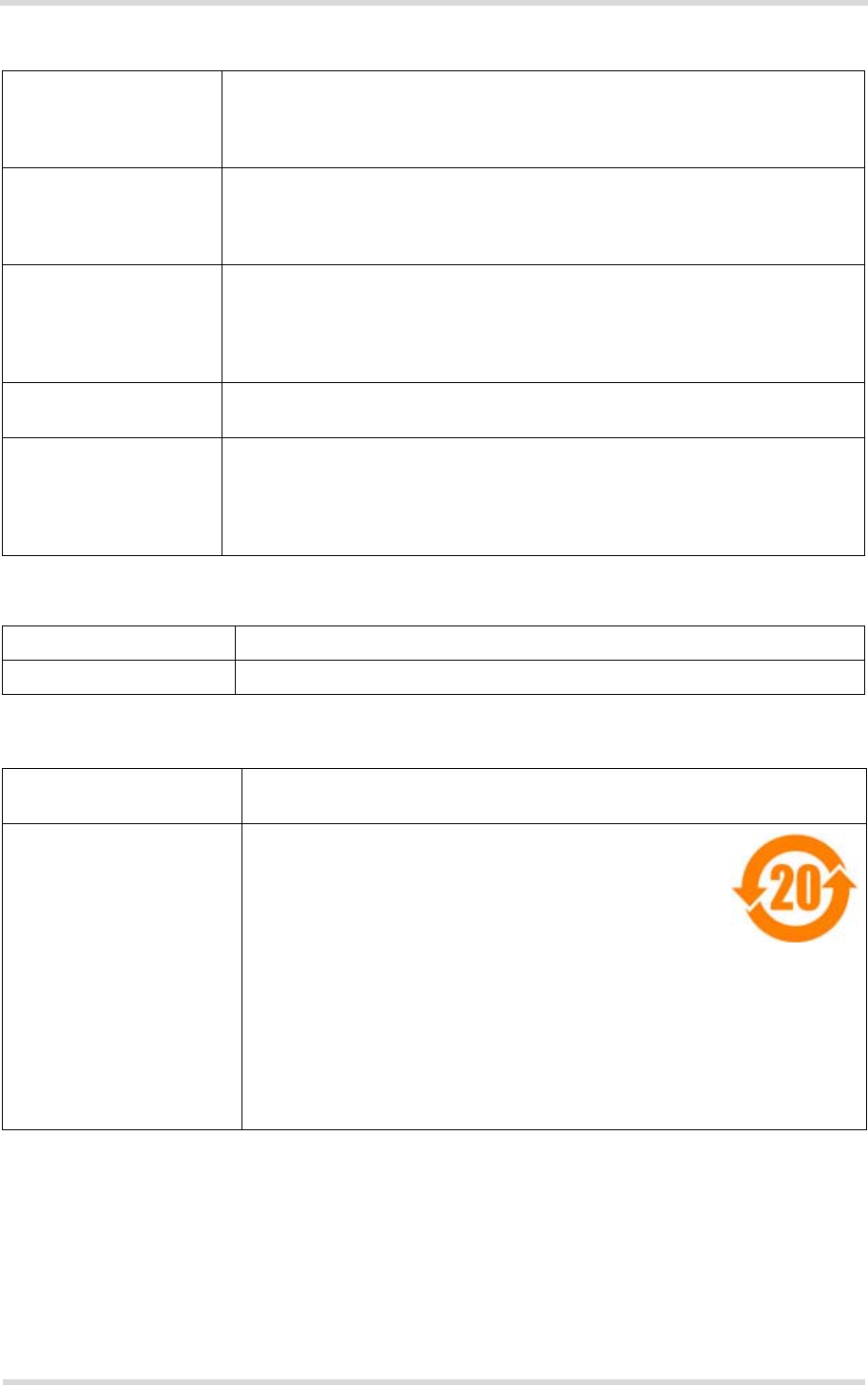
Cinterion® ELS61-US Hardware Interface Overview
5.1 Directives and Standards
32
ELS61-US_HIO_v00.281 2016-02-11
Confidential / Preliminary
Page 27 of 40
ETSI EN 301 489-24
V1.5.1
Electromagnetic Compatibility and Radio spectrum Matters (ERM); Electro-
magnetic Compatibility (EMC) standard for radio equipment and services;
Part 24: Specific conditions for IMT-2000 CDMA Direct Spread (UTRA) for
Mobile and portable (UE) radio and ancillary equipment
ETSI EN 301 908-01
V5.2.1
Electromagnetic compatibility and Radio spectrum Matters (ERM); Base
Stations (BS) and User Equipment (UE) for IMT-2000 Third Generation cel-
lular networks; Part 1: Harmonized EN for IMT-2000, introduction and com-
mon requirements of article 3.2 of the R&TTE Directive
ETSI EN 301 908-02
V5.2.1
Electromagnetic compatibility and Radio spectrum Matters (ERM); Base
Stations (BS) and User Equipment (UE) for IMT-2000 Third Generation cel-
lular networks; Part 2: Harmonized EN for IMT-2000, CDMA Direct Spread
(UTRA FDD) (UE) covering essential requirements of article 3.2 of the
R&TTE Directive
EN 62311:2008 Assessment of electronic and electrical equipment related to human expo-
sure restrictions for electromagnetic fields (0 Hz - 300 GHz)
IEC/EN 60950-1:2006/
A1:2010+A12:2011
IEC 60950-1:2005/
A1:2009
(second edition)
Safety of information technology equipment
Table 8: Requirements of quality
IEC 60068 Environmental testing
DIN EN 60529 IP codes
Table 9: Standards of the Ministry of Information Industry of the People’s Republic of China
SJ/T 11363-2006 “Requirements for Concentration Limits for Certain Hazardous Sub-
stances in Electronic Information Products” (2006-06).
SJ/T 11364-2006 “Marking for Control of Pollution Caused by Electronic
Information Products” (2006-06).
According to the “Chinese Administration on the Control
of Pollution caused by Electronic Information Products”
(ACPEIP) the EPUP, i.e., Environmental Protection Use
Period, of this product is 20 years as per the symbol
shown here, unless otherwise marked. The EPUP is valid only as long as
the product is operated within the operating limits described in the
Gemalto M2M Hardware Interface Description.
Please see Table 10 for an overview of toxic or hazardous substances or
elements that might be contained in product parts in concentrations
above the limits defined by SJ/T 11363-2006.
Table 7: Standards of European type approval

Cinterion® ELS61-US Hardware Interface Overview
5.2 SAR requirements specific to portable mobiles
32
ELS61-US_HIO_v00.281 2016-02-11
Confidential / Preliminary
Page 29 of 40
5.2 SAR requirements specific to portable mobiles
Mobile phones, PDAs or other portable transmitters and receivers incorporating a UMTS mod-
ule must be in accordance with the guidelines for human exposure to radio frequency energy.
This requires the Specific Absorption Rate (SAR) of portable ELS61-US based applications to
be evaluated and approved for compliance with national and/or international regulations.
Since the SAR value varies significantly with the individual product design manufacturers are
advised to submit their product for approval if designed for portable use. For US-markets the
relevant directives are mentioned below. It is the responsibility of the manufacturer of the final
product to verify whether or not further standards, recommendations or directives are in force
outside these areas.
Products intended for sale on US markets
ES 59005/ANSI C95.1 Considerations for evaluation of human exposure to Electromagnetic
Fields (EMFs) from Mobile Telecommunication Equipment (MTE) in the
frequency range 30MHz - 6GHz
Please note that SAR requirements are specific only for portable devices and not for mobile
devices as defined below:
• Portable device:
A portable device is defined as a transmitting device designed to be used so that the radi-
ating structure(s) of the device is/are within 20 centimeters of the body of the user.
• Mobile device:
A mobile device is defined as a transmitting device designed to be used in other than fixed
locations and to generally be used in such a way that a separation distance of at least 20
centimeters is normally maintained between the transmitter's radiating structure(s) and the
body of the user or nearby persons. In this context, the term ''fixed location'' means that the
device is physically secured at one location and is not able to be easily moved to another
location.
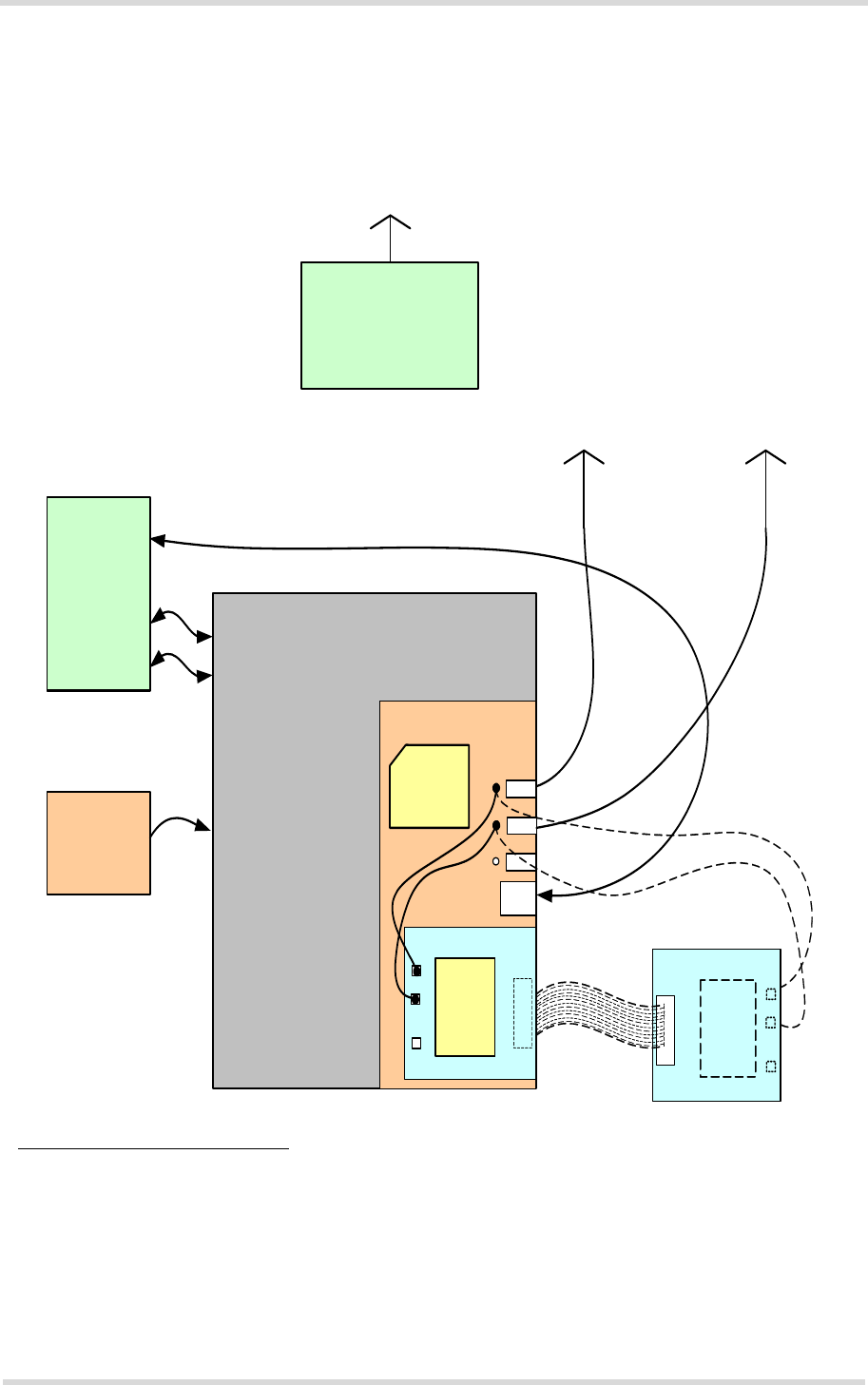
Cinterion® ELS61-US Hardware Interface Overview
5.3 Reference Equipment for Type Approval
32
ELS61-US_HIO_v00.281 2016-02-11
Confidential / Preliminary
Page 30 of 40
5.3 Reference Equipment for Type Approval
The Gemalto M2M reference setup submitted to type approve ELS61-US (including a special
approval adapter for the DSB75) is shown in the following figure1:
Figure 9: Reference equipment for Type Approval
1. For RF performance tests a mini-SMT/U.FL to SMA adapter with attached 6dB coaxial attenuator is cho-
sen to connect the evaluation module directly to the UMTS test equipment instead of employing the SMA
antenna connectors on the ELS61-US-DSB75 adapter as shown in Figure 9. The following products are
recommended:
Hirose SMA-Jack/U.FL-Plug conversion adapter HRMJ-U.FLP(40)
(for details see http://www.hirose-connectors.com/ or http://www.farnell.com/
Aeroflex Weinschel Fixed Coaxial Attenuator Model 3T/4T
(for details see http://www.aeroflex.com/ams/weinschel/pdfiles/wmod3&4T.pdf)
Antenna
Ma i n
Antenna
ASC0
PC
Power
Suppl y
LTE / UMTS
Base Stati on
DSB75
ASC1
USB
Approval adapter
for DSB75
SMA
USB
SIM Card
SMA
SMA
Rx diversity
Antenna
Evaluation module
ELS61
Evaluation module
ELS61
Top view
Bottom view

Cinterion® ELS61-US Hardware Interface Overview
5.4 Compliance with FCC and IC Rules and Regulations
32
ELS61-US_HIO_v00.281 2016-02-11
Confidential / Preliminary
Page 31 of 40
5.4 Compliance with FCC and IC Rules and Regulations
The Equipment Authorization Certification for the Gemalto M2M reference application de-
scribed in Section 5.3 will be registered under the following identifiers:
FCC Identifier: QIPELS61-US
Industry Canada Certification Number: 7830A-ELS61US
Granted to Gemalto M2M GmbH
Manufacturers of mobile or fixed devices incorporating ELS61-US modules are authorized to
use the FCC Grants and Industry Canada Certificates of the ELS61-US modules for their own
final products according to the conditions referenced in these documents. In this case, an FCC/
IC label of the module shall be visible from the outside, or the host device shall bear a second
label stating "Contains FCC ID: QIPELS61-US", and accordingly “Contains IC: 7830A-
ELS61US“. The integration is limited to fixed or mobile categorized host devices, where a sepa-
ration distance between the antenna and any person of min. 20cm can be assured during nor-
mal operating conditions. For mobile and fixed operation configurations the antenna gain,
including cable loss, must not exceed the limit 2.15 dBi for 700MHz, 850MHz, 1700MHz and
1900MHz.
IMPORTANT:
Manufacturers of portable applications incorporating ELS61-US modules are required to have
their final product certified and apply for their own FCC Grant and Industry Canada Certificate
related to the specific portable mobile. This is mandatory to meet the SAR requirements for por-
table mobiles (see Section 5.2 for detail).
Changes or modifications not expressly approved by the party responsible for compliance
could void the user's authority to operate the equipment.
Note: This equipment has been tested and found to comply with the limits for a Class B digital
device, pursuant to part 15 of the FCC Rules and with Industry Canada licence-exempt RSS
standard(s). These limits are designed to provide reasonable protection against harmful inter-
ference in a residential installation. This equipment generates, uses and can radiate radio fre-
quency energy and, if not installed and used in accordance with the instructions, may cause
harmful interference to radio communications. However, there is no guarantee that interference
will not occur in a particular installation. If this equipment does cause harmful interference to
radio or television reception, which can be determined by turning the equipment off and on, the
user is encouraged to try to correct the interference by one or more of the following measures:
• Reorient or relocate the receiving antenna.
• Increase the separation between the equipment and receiver.
• Connect the equipment into an outlet on a circuit different from that to which the receiver is
connected.
• Consult the dealer or an experienced radio/TV technician for help.
This Class B digital apparatus complies with Canadian ICES-003.

Cinterion® ELS61-US Hardware Interface Overview
5.4 Compliance with FCC and IC Rules and Regulations
32
ELS61-US_HIO_v00.281 2016-02-11
Confidential / Preliminary
Page 32 of 40
If Canadian approval is requested for devices incorporating ELS61-US modules the below
notes will have to be provided in the English and French language in the final user documen-
tation. Manufacturers/OEM Integrators must ensure that the final user documentation does not
contain any information on how to install or remove the module from the final product.
Notes (IC):
(EN) This Class B digital apparatus complies with Canadian ICES-003 and RSS-210. Opera-
tion is subject to the following two conditions: (1) this devive may not cause interference, and
(2) this device must accept any interference, including interference that may cause undesired
operation of the device.
(FR) Cet appareil numérique de classe B est conforme aux normes canadiennes ICES-003 et
RSS-210. Son fonctionnement est soumis aux deux conditions suivantes: (1) cet appareil ne
doit pas causer d'interférence et (2) cet appareil doit accepter toute interférence, notamment
les interférences qui peuvent affecter son fonctionnement.
(EN) Radio frequency (RF) Exposure Information
The radiated output power of the Wireless Device is below the Industry Canada (IC) radio fre-
quency exposure limits. The Wireless Device should be used in such a manner such that the
potential for human contact during normal operation is minimized.
This device has also been evaluated and shown compliant with the IC RF Exposure limits un-
der mobile exposure conditions. (antennas are greater than 20cm from a person‘s body).
(FR) Informations concernant l'exposltion aux fréquences radio (RF)
La puissance de sortie émise par l'appareil de sans fiI est inférieure à la limite d'exposition aux
fréquences radio d‘Industry Canada (IC). Utilisez l'appareil de sans fil de façon à minimiser les
contacts humains lors du fonctionnement normal.
Ce périphérique a également été évalué et démontré conforme aux limites d'exposition aux RF
d'IC dans des conditions d'exposition à des appareils mobiles (les antennes se situent à moins
de 20cm du corps d'une personne).

Cinterion® ELS61-US Hardware Interface Overview
6 Document Information
37
ELS61-US_HIO_v00.281 2016-02-11
Confidential / Preliminary
Page 33 of 40
6 Document Information
6.1 Revision History
New document: "Cinterion® ELS61-US Hardware Interface Overview" Version 00.281
6.2 Related Documents
[1] ELS61-US AT Command Set
[2] ELS61-US Release Note
[3] Application Note 48: SMT Module Integration
[4] Application Note 40: Thermal Solutions
[5] Universal Serial Bus Specification Revision 2.0, April 27, 2000
Chapter What is new
-- Initial document setup.

Cinterion® ELS61-US Hardware Interface Overview
6.3 Terms and Abbreviations
37
ELS61-US_HIO_v00.281 2016-02-11
Confidential / Preliminary
Page 34 of 40
6.3 Terms and Abbreviations
Abbreviation Description
ADC Analog-to-digital converter
AGC Automatic Gain Control
ANSI American National Standards Institute
ARFCN Absolute Radio Frequency Channel Number
ARP Antenna Reference Point
ASC0/ASC1 Asynchronous Controller. Abbreviations used for first and second serial interface of
ELS61-US
B Thermistor Constant
BER Bit Error Rate
BIP Bearer Independent Protocol
BTS Base Transceiver Station
CB or CBM Cell Broadcast Message
CE Conformité Européene (European Conformity)
CHAP Challenge Handshake Authentication Protocol
CPU Central Processing Unit
CS Coding Scheme
CSD Circuit Switched Data
CTS Clear to Send
DAC Digital-to-Analog Converter
DAI Digital Audio Interface
dBm0 Digital level, 3.14dBm0 corresponds to full scale, see ITU G.711, A-law
DCE Data Communication Equipment (typically modems, e.g. Gemalto M2M module)
DRX Discontinuous Reception
DSB Development Support Box
DSP Digital Signal Processor
DSR Data Set Ready
DTE Data Terminal Equipment (typically computer, terminal, printer or, for example, UMTS
application)
DTR Data Terminal Ready
DTX Discontinuous Transmission
EFR Enhanced Full Rate
EIRP Equivalent Isotropic Radiated Power
EMC Electromagnetic Compatibility
ERP Effective Radiated Power
ESD Electrostatic Discharge
ETS European Telecommunication Standard

Cinterion® ELS61-US Hardware Interface Overview
6.3 Terms and Abbreviations
37
ELS61-US_HIO_v00.281 2016-02-11
Confidential / Preliminary
Page 35 of 40
FCC Federal Communications Commission (U.S.)
FDMA Frequency Division Multiple Access
FR Full Rate
GMSK Gaussian Minimum Shift Keying
GPIO General Purpose Input/Output
HiZ High Impedance
HR Half Rate
I/O Input/Output
IC Integrated Circuit
IMEI International Mobile Equipment Identity
ISO International Standards Organization
ITU International Telecommunications Union
kbps kbits per second
LED Light Emitting Diode
Li-Ion/Li+ Lithium-Ion
Li battery Rechargeable Lithium Ion or Lithium Polymer battery
LPM Link Power Management
Mbps Mbits per second
MMI Man Machine Interface
MO Mobile Originated
MS Mobile Station (UMTS module), also referred to as TE
MSISDN Mobile Station International ISDN number
MT Mobile Terminated
NTC Negative Temperature Coefficient
OEM Original Equipment Manufacturer
PA Power Amplifier
PAP Password Authentication Protocol
PBCCH Packet Switched Broadcast Control Channel
PCB Printed Circuit Board
PCL Power Control Level
PDU Protocol Data Unit
PLL Phase Locked Loop
PPP Point-to-point protocol
PSK Phase Shift Keying
PSU Power Supply Unit
PWM Pulse Width Modulation
R&TTE Radio and Telecommunication Terminal Equipment
Abbreviation Description

Cinterion® ELS61-US Hardware Interface Overview
6.3 Terms and Abbreviations
37
ELS61-US_HIO_v00.281 2016-02-11
Confidential / Preliminary
Page 36 of 40
RAM Random Access Memory
RF Radio Frequency
RLS Radio Link Stability
RMS Root Mean Square (value)
RoHS Restriction of the use of certain hazardous substances in electrical and electronic
equipment.
ROM Read-only Memory
RTC Real Time Clock
RTS Request to Send
Rx Receive Direction
SAR Specific Absorption Rate
SAW Surface Accoustic Wave
SELV Safety Extra Low Voltage
SIM Subscriber Identification Module
SMD Surface Mount Device
SMS Short Message Service
SMT Surface Mount Technology
SPI Serial Peripheral Interface
SRAM Static Random Access Memory
TA Terminal adapter (e.g. UMTS module)
TDMA Time Division Multiple Access
TE Terminal Equipment, also referred to as DTE
TLS Transport Layer Security
Tx Transmit Direction
UART Universal asynchronous receiver-transmitter
URC Unsolicited Result Code
USSD Unstructured Supplementary Service Data
VSWR Voltage Standing Wave Ratio
Abbreviation Description
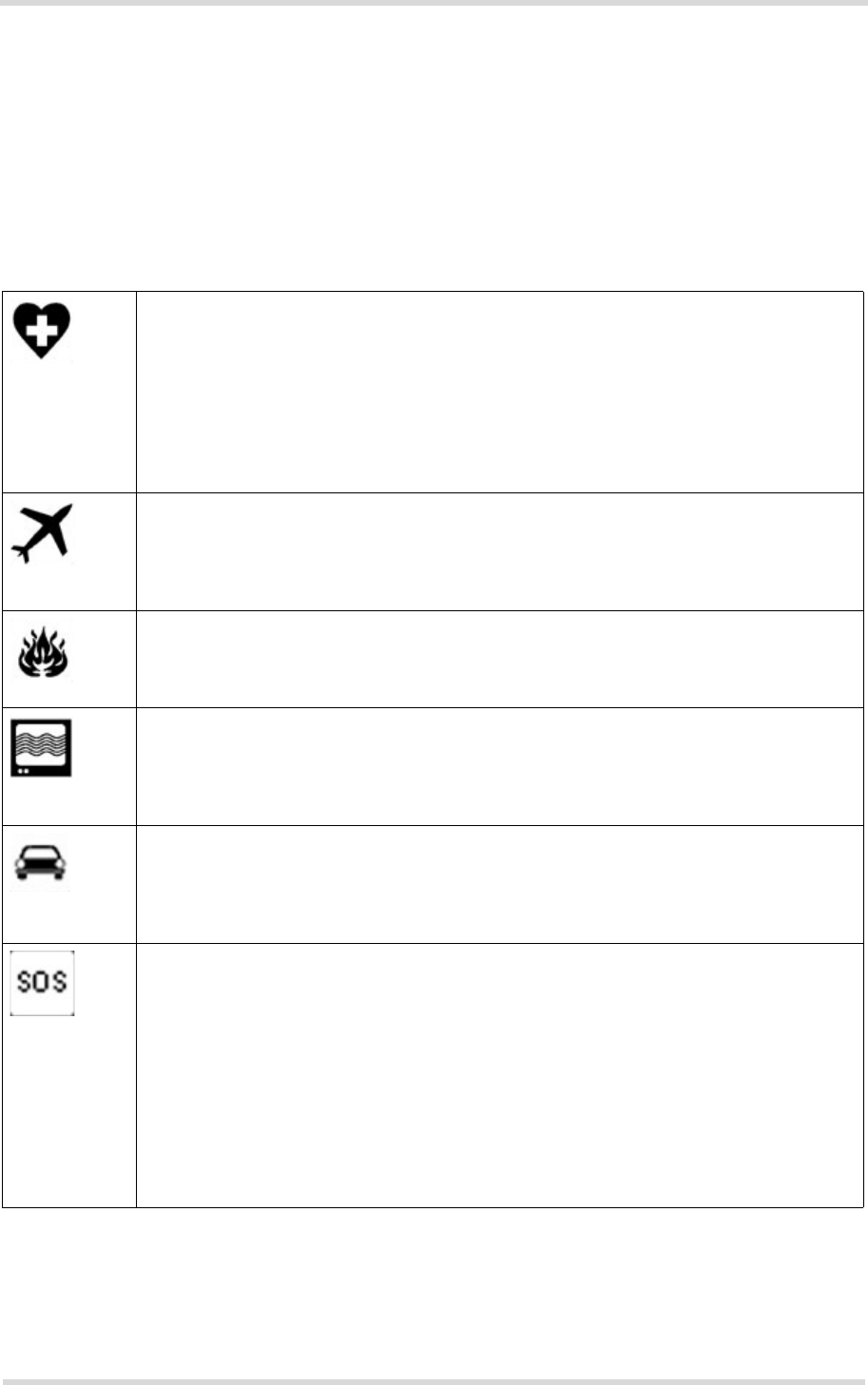
Cinterion® ELS61-US Hardware Interface Overview
6.4 Safety Precaution Notes
37
ELS61-US_HIO_v00.281 2016-02-11
Confidential / Preliminary
Page 37 of 40
6.4 Safety Precaution Notes
The following safety precautions must be observed during all phases of the operation, usage,
service or repair of any cellular terminal or mobile incorporating ELS61-US. Manufacturers of
the cellular terminal are advised to convey the following safety information to users and oper-
ating personnel and to incorporate these guidelines into all manuals supplied with the product.
Failure to comply with these precautions violates safety standards of design, manufacture and
intended use of the product. Gemalto M2M assumes no liability for customer’s failure to comply
with these precautions.
When in a hospital or other health care facility, observe the restrictions on the use of
mobiles. Switch the cellular terminal or mobile off, if instructed to do so by the guide-
lines posted in sensitive areas. Medical equipment may be sensitive to RF energy.
The operation of cardiac pacemakers, other implanted medical equipment and hear-
ing aids can be affected by interference from cellular terminals or mobiles placed close
to the device. If in doubt about potential danger, contact the physician or the manufac-
turer of the device to verify that the equipment is properly shielded. Pacemaker
patients are advised to keep their hand-held mobile away from the pacemaker, while
it is on.
Switch off the cellular terminal or mobile before boarding an aircraft. Make sure it can-
not be switched on inadvertently. The operation of wireless appliances in an aircraft is
forbidden to prevent interference with communications systems. Failure to observe
these instructions may lead to the suspension or denial of cellular services to the
offender, legal action, or both.
Do not operate the cellular terminal or mobile in the presence of flammable gases or
fumes. Switch off the cellular terminal when you are near petrol stations, fuel depots,
chemical plants or where blasting operations are in progress. Operation of any elec-
trical equipment in potentially explosive atmospheres can constitute a safety hazard.
Your cellular terminal or mobile receives and transmits radio frequency energy while
switched on. Remember that interference can occur if it is used close to TV sets,
radios, computers or inadequately shielded equipment. Follow any special regulations
and always switch off the cellular terminal or mobile wherever forbidden, or when you
suspect that it may cause interference or danger.
Road safety comes first! Do not use a hand-held cellular terminal or mobile when driv-
ing a vehicle, unless it is securely mounted in a holder for speakerphone operation.
Before making a call with a hand-held terminal or mobile, park the vehicle.
Speakerphones must be installed by qualified personnel. Faulty installation or opera-
tion can constitute a safety hazard.
IMPORTANT!
Cellular terminals or mobiles operate using radio signals and cellular networks.
Because of this, connection cannot be guaranteed at all times under all conditions.
Therefore, you should never rely solely upon any wireless device for essential com-
munications, for example emergency calls.
Remember, in order to make or receive calls, the cellular terminal or mobile must be
switched on and in a service area with adequate cellular signal strength.
Some networks do not allow for emergency calls if certain network services or phone
features are in use (e.g. lock functions, fixed dialing etc.). You may need to deactivate
those features before you can make an emergency call.
Some networks require that a valid SIM card be properly inserted in the cellular termi-
nal or mobile.

Cinterion® ELS61-US Hardware Interface Overview
7 Appendix
39
ELS61-US_HIO_v00.281 2016-02-11
Confidential / Preliminary
Page 38 of 40
7 Appendix
7.1 List of Parts and Accessories
Table 11: List of parts and accessories
Description Supplier Ordering information
ELS61-US Gemalto M2M Standard module
Gemalto M2M IMEI:
Packaging unit (ordering) number: L30960-N4401-A100
Module label number: S30960-S4401-A100-1
ELS61-US Evaluation Mod-
ule
Gemalto M2M Ordering number: L30960-N4400-A100 (ELS61-US)
DSB75 Evaluation Kit Gemalto M2M Ordering number: L36880-N8811-A100
DSB Mini
Compact Evaluation Board
Gemalto M2M Ordering number: L30960-N0030-A100
Starter Kit B80 Gemalto M2M Ordering Number L30960-N0040-A100
Multi-Adapter R1 for mount-
ing ELS61-US evaluation
modules onto DSB75
Gemalto M2M Ordering number: L30960-N0010-A100
Approval adapter for mount-
ing ELS61-US evaluation
modules onto DSB75
Gemalto M2M Ordering number: L30960-N2301-A100
Votronic Handset Votronic /
Gemalto M2M
Gemalto M2M ordering number: L36880-N8301-A107
Votronic ordering number: HH-SI-30.3/V1.1/0
Votronic
Entwicklungs- und Produktionsgesellschaft für elek-
tronische Geräte mbH
Saarbrücker Str. 8
66386 St. Ingbert
Germany
Phone: +49-(0)6 89 4 / 92 55-0
Fax: +49-(0)6 89 4 / 92 55-88
Email: contact@votronic.com
SIM card holder incl. push
button ejector and slide-in
tray
Molex Ordering numbers: 91228
91236
Sales contacts are listed in Table 12.

Cinterion® ELS61-US Hardware Interface Overview
7.1 List of Parts and Accessories
39
ELS61-US_HIO_v00.281 2016-02-11
Confidential / Preliminary
Page 39 of 40
Table 12: Molex sales contacts (subject to change)
Molex
For further information please click:
http://www.molex.com
Molex Deutschland GmbH
Otto-Hahn-Str. 1b
69190 Walldorf
Germany
Phone: +49-6227-3091-0
Fax: +49-6227-3091-8100
Email: mxgermany@molex.com
American Headquarters
Lisle, Illinois 60532
U.S.A.
Phone: +1-800-78MOLEX
Fax: +1-630-969-1352
Molex China Distributors
Beijing,
Room 1311, Tower B, COFCO Plaza
No. 8, Jian Guo Men Nei Street, 100005
Beijing
P.R. China
Phone: +86-10-6526-9628
Fax: +86-10-6526-9730
Molex Singapore Pte. Ltd.
110, International Road
Jurong Town,
Singapore 629174
Phone: +65-6-268-6868
Fax: +65-6-265-6044
Molex Japan Co. Ltd.
1-5-4 Fukami-Higashi,
Yamato-City,
Kanagawa, 242-8585
Japan
Phone: +81-46-265-2325
Fax: +81-46-265-2365

40
M2M.GEMALTO.COM
About Gemalto
Gemalto (Euronext NL0000400653 GTO) is the world leader in digital security with 2014 annual
revenues of €2.5 billion and blue-chip customers in over 180 countries. Our 14,000 employees
operate out of 99 offices, 34 personalization and data centers, and 24 research and software
development centers located in 46 countries.
We are at the heart of the rapidly evolving digital society. Billions of people worldwide increasingly
want the freedom to communicate, travel, shop, bank, entertain and work - anytime, everywhere
- in ways that are enjoyable and safe. Gemalto delivers on their expanding needs for personal
mobile services, payment security, authenticated cloud access, identity and privacy protection,
eHealthcare and eGovernment efficiency, convenient ticketing and dependable machine-to-
machine (M2M) applications.
Gemalto develops secure embedded software and secure products which we design and
personalize. Our platforms and services manage these secure products, the confidential data they
contain and the trusted end-user services they enable. Our innovations enable our clients to offer
trusted and convenient digital services to billions of individuals.
Gemalto thrives with the growing number of people using its solutions to interact with the digital
and wireless world.
For more information please visit
m2m.gemalto.com, www.facebook.com/gemalto, or Follow@gemaltom2m on twitter.
Gemalto M2M GmbH
St.-Martin-Str. 60
81541 Munich
Germany
© Gemalto 2016. All rights reserved. Gemalto, the Gemalto logo, are trademarks and service marks of Gemalto and are registered in certain countries. April 2013
